Trinidad and Tobago is an island nation located in the Caribbean Sea and is known for its vibrant culture and stunning scenery. This also includes its diverse bird population.
From the majestic Scarlet Ibis to the endangered Trinidad Piping-Guan, the birds of Trinidad and Tobago are some of the most exotic and stunning specimens found anywhere in the world.
Bird watching tours are popular in this area and are a great way to observe these beautiful creatures in their natural habitats. With over 350 species of birds in Trinidad and Tobago, it is no wonder that bird watchers of all levels can find something to marvel at.
1. Scarlet Ibis
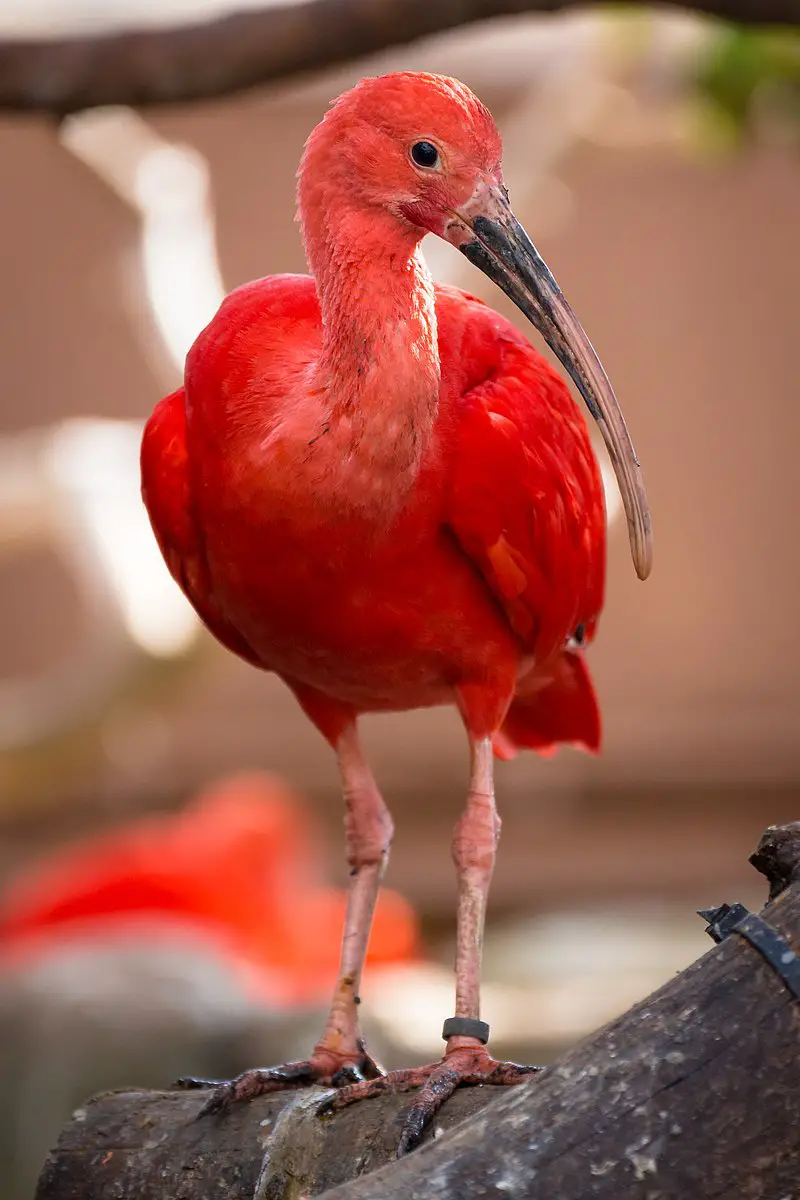
The Scarlet Ibis is a stunning bird, native to tropical South America and the Caribbean. With its distinctive scarlet coloration, it stands out from other ibises in the Threskiornithidae family.
It has become one of two national birds of Trinidad and Tobago with a Tupi-Guarani name: guará.
This species can grow up to 28 inches long with an impressive wingspan of 39–41 inches wide.
The striking red feathers are found mainly on their body while wings, head and neck range from white or greyish colors.
They have black legs with pink webbed feet that help them thrive as they wade through shallow water searching for food such as shrimp, crabs and small fish – all essential components to their diet.
Despite its beauty, this species faces threats due increasing habitat destruction caused by deforestation practices in areas where it lives making conservation efforts crucial for protecting these majestic creatures before they disappear forever .
Scientific classification:
| Kingdom | Animalia |
| Phylum | Chordata |
| Class | Aves |
| Order | Pelecaniformes |
| Family | Threskiornithidae |
| Genus | Eudocimus |
| Species | E. ruber |
2. Rufous-Vented Chachalaca
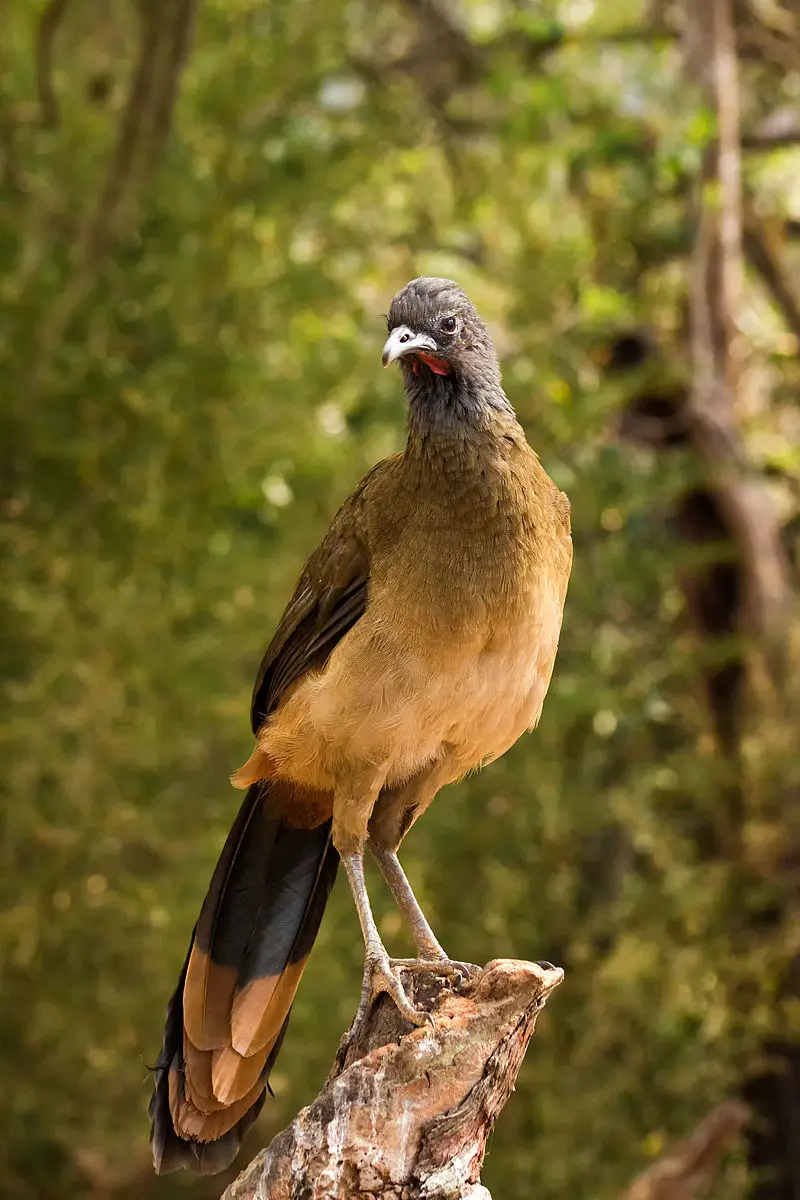
The Rufous-vented Chachalaca is a fascinating bird species, belonging to the ancient family of Cracids.
It can be found in northeast Colombia and northern Venezuela (where it’s known as guacharaca), as well as on Tobago island in Trinidad and Tobago where it’s called cocrico – one of the country’s two national birds.
With its reddish brown plumage, bright red vent feathers and white stripe above each eye, this unique looking creature stands out from other avian species.
Its diet includes fruits, nuts, seeds and leaves; while they also feed on insects such as grasshoppers or beetles if available.
The rufous-vented chachalaca typically live in groups ranging between 2–15 individuals which form strong bonds amongst themselves.
This charming bird deserves much more recognition for its beauty and uniqueness.
Scientific classification:
| Kingdom | Animalia |
| Phylum | Chordata |
| Class | Aves |
| Order | Galliformes |
| Family | Cracidae |
| Genus | Ortalis |
| Species | O. ruficauda |
3. Tufted Coquette
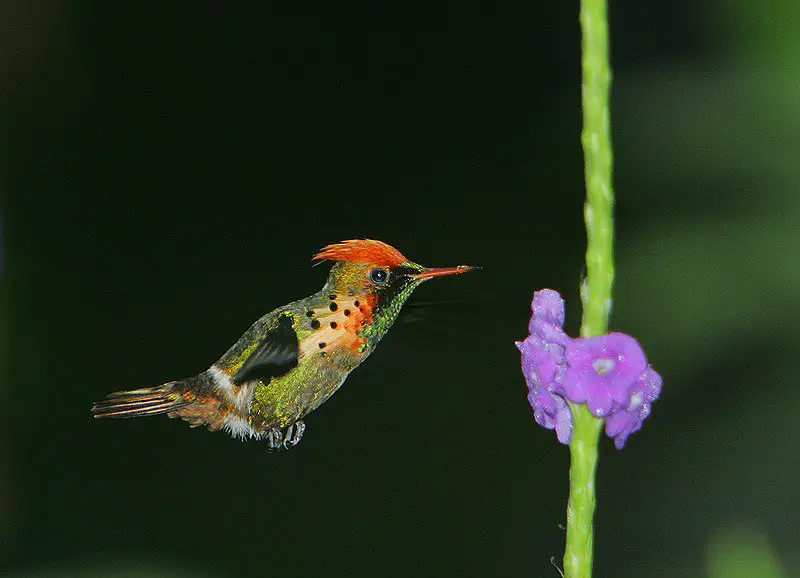
The Tufted Coquette is a small hummingbird native to eastern Venezuela, Trinidad, Guiana and northern Brazil. It inhabits open country such as gardens and cultivated areas.
This bird has an unusual crest which gives it its name – tufted coquette – first described by the famous French polymaths in 1760.
The species is quite common but not well understood due their migratory behaviors; they appear to move around locally or seasonally yet this remains unknown for now.
They are tiny birds with green bodies and white bellies that can reach up to 4 inches long when fully grown.
Their wingspan ranges from 3-4 inches wide during flight so they look much bigger than they actually are. These little creatures feed on nectar of various flowers while also eating insects like moths, bees and butterflies along the way.
Scientific classification:
| Kingdom | Animalia |
| Phylum | Chordata |
| Class | Aves |
| Order | Apodiformes |
| Family | Trochilidae |
| Genus | Lophornis |
| Species | L. ornatus |
4. Copper-Rumped Hummingbird
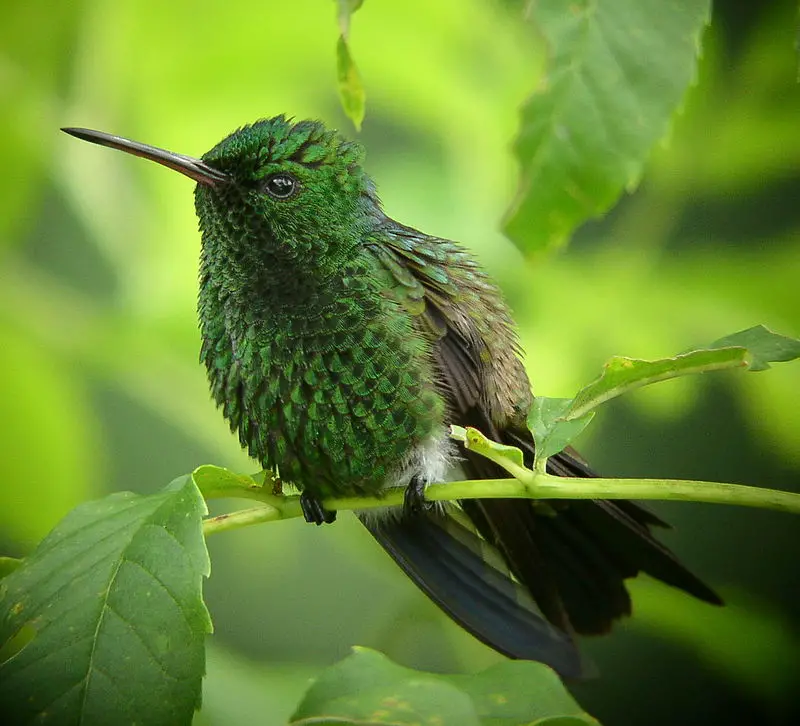
The Copper-rumped Hummingbird is a stunning species of hummingbird found in Tobago, Trinidad, Venezuela and potentially Grenada.
It was first described by German naturalist Johann Friedrich Gmelin in 1788 as part of his revised edition to the Systema Naturae created by Carl Linnaeus.
This small bird has an emerald green head with a copper rump patch on its back that gives it its name.
Its wings are mainly black with metallic blue feathers near their tips while its tail consists of white outer rectrices tipped with grayish brown and central ones being mostly grayish brown colored.
The male also possesses bright orange gorget feathers which helps distinguish itself from other birds during mating season.
Despite its size this remarkable species can fly up to 25 mph making them one of nature’s wonders.
Scientific classification:
| Kingdom | Animalia |
| Phylum | Chordata |
| Class | Aves |
| Order | Apodiformes |
| Family | Trochilidae |
| Genus | Saucerottia |
| Species | S. tobaci |
5. Black-Throated Mango
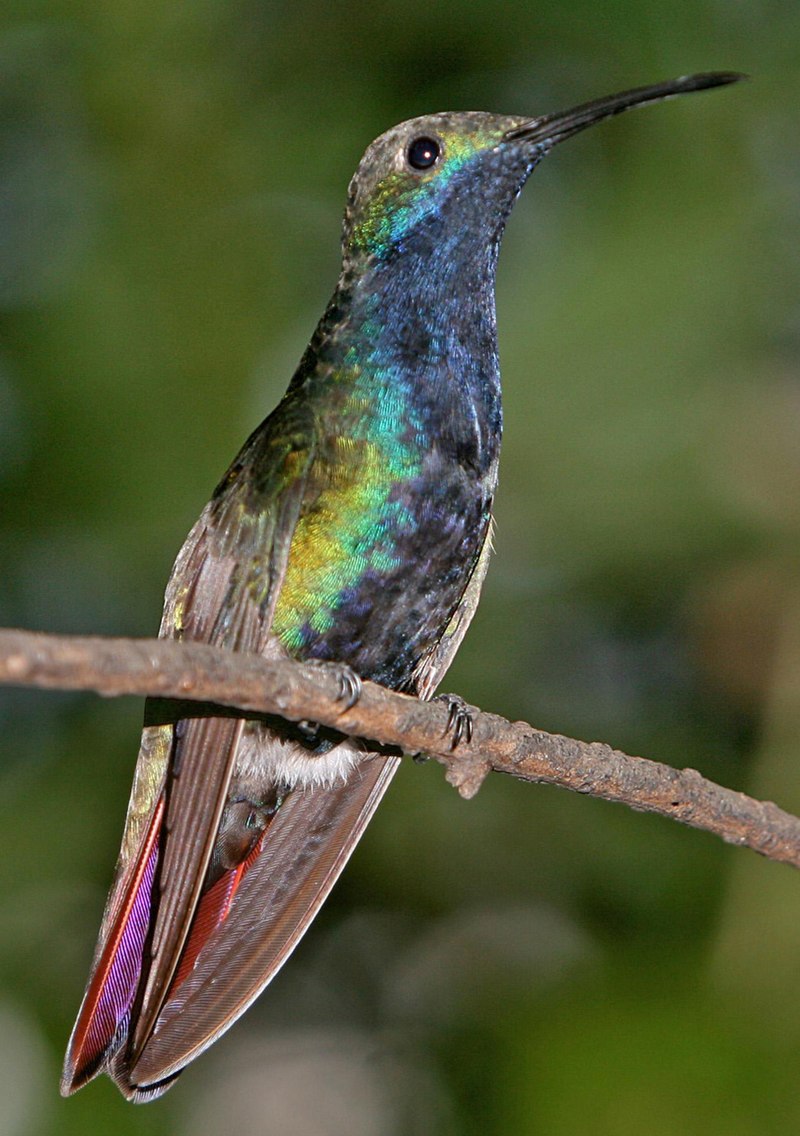
The Black-throated Mango is a beautiful species of hummingbird native to South America and Trinidad and Tobago.
It measures 10.2 cm in length, with its long black bill slightly curved at the end.
The male has bright green upperparts, while his throat and chest are matt black bordered by an iridescent golden collar on the nape area which gives it a striking appearance.
Its tail feathers have dark central ones with wine-red tips that contrast sharply with the rest of its plumage.
Females display similar features but paler than males, having greyish green upper parts without any gold or red coloration on their tails.
Despite being small in size, this bird can be easily spotted due to it’s colorful body and vibrant song.
Scientific classification:
| Kingdom | Animalia |
| Phylum | Chordata |
| Class | Aves |
| Order | Apodiformes |
| Family | Trochilidae |
| Genus | Anthracothorax |
| Species | A. nigricollis |
Also Featured In: Birds that Live in Guyana,
6. Yellow Oriole
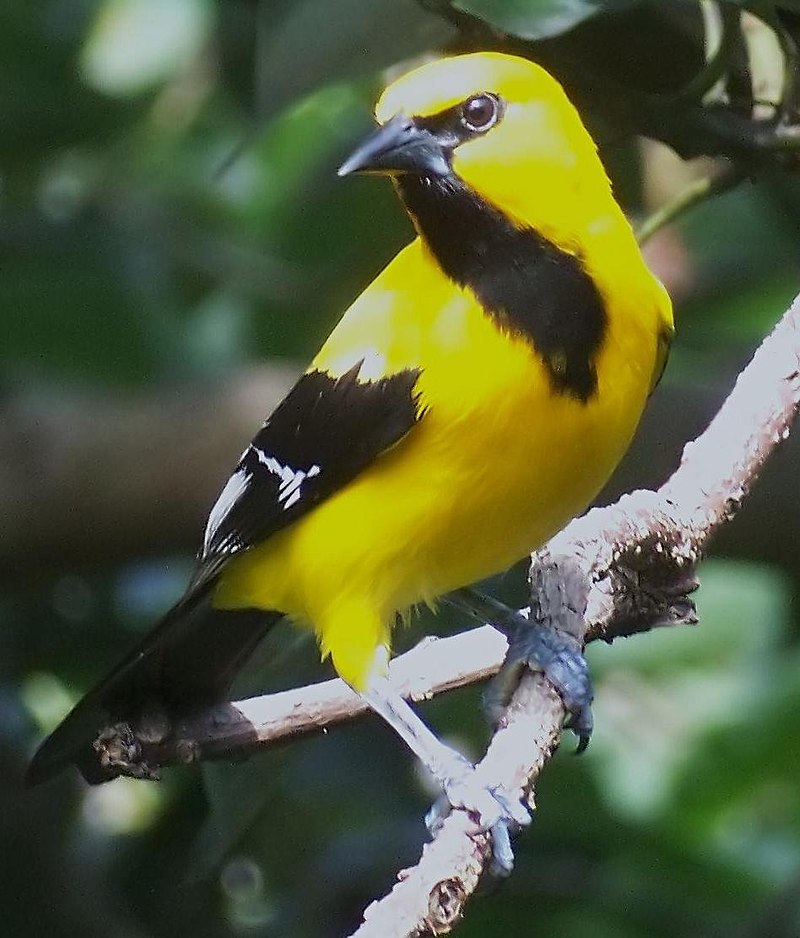
The Yellow Oriole is a beautiful passerine bird belonging to the Icteridae family. It has yellow feathers on its head, wings and back with black stripes running across them while it’s underparts are bright white in colour.
The adult male has an orange-yellow throat patch and females have grey throats.
They can be found breeding in northern South America where they inhabit dense woodland areas and open savanna habitats close to rivers or lakes.
Known as the Plantain Bird or Small Corn Bird by locals, these birds feed mainly on insects but will also consume fruits such as plantains and small corn grains for their diet. In Venezuela they’re known affectionately as ‘Gonzalito’.
A truly stunning species of wildlife worth keeping an eye out for when travelling through South America.
Scientific classification:
| Kingdom | Animalia |
| Phylum | Chordata |
| Class | Aves |
| Order | Passeriformes |
| Family | Icteridae |
| Genus | Icterus |
| Species | I. nigrogularis |
Also Featured In: Caribbean Birds, Common Margarita Island Birds
7. Ferruginous Pygmy Owl
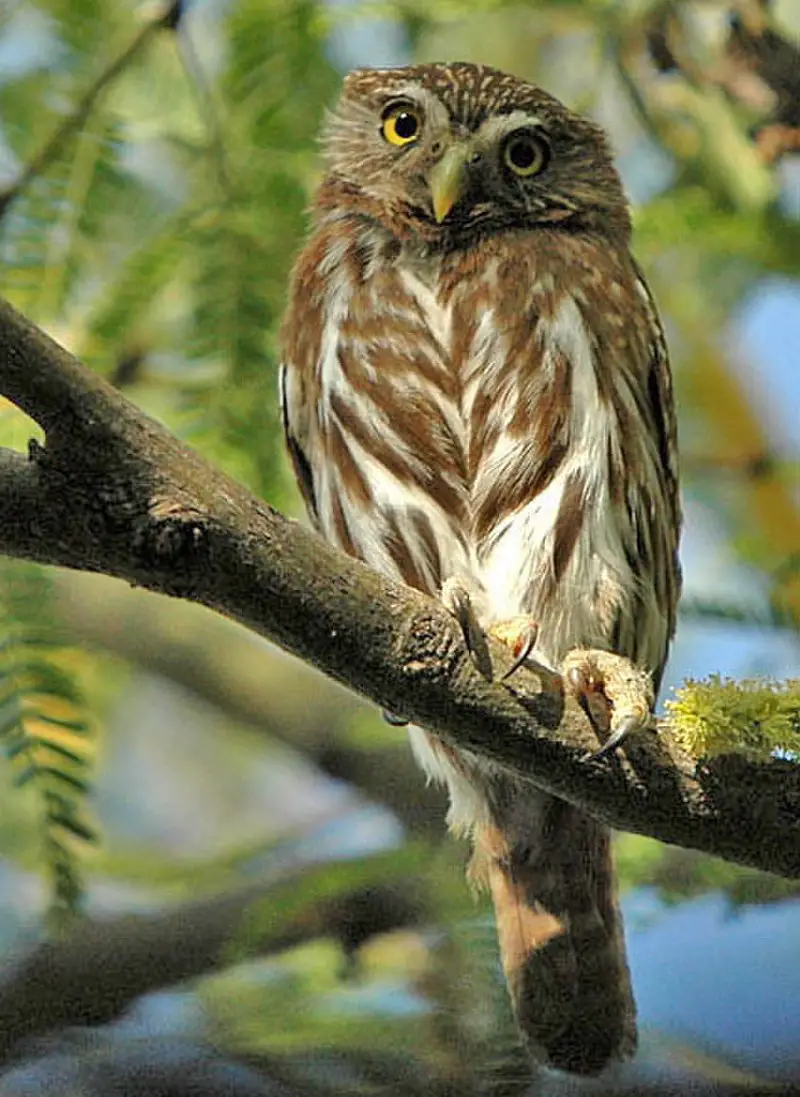
The ferruginous pygmy owl is a small species of owl that can be found throughout much of Central and South America, as well as parts of the United States.
It has rusty-brown feathers on its body, giving it an overall “ferruginous” colouration. The bird feeds mainly on insects and other invertebrates, but also eats some larger prey such as lizards or mice when available.
During breeding season the birds build nests in tree cavities to raise their young. They are usually nocturnal creatures but may become active during daylight hours if disturbed by humans or predators nearby.
This adaptable little raptor is often seen perching atop buildings or street lights in urban areas where they have adapted to live alongside human activity while still finding food sources within cities and townships alike.
Scientific classification:
| Kingdom | Animalia |
| Phylum | Chordata |
| Class | Aves |
| Order | Strigiformes |
| Family | Strigidae |
| Genus | Glaucidium |
| Species | G. brasilianum |
8. Ruddy Ground Dove
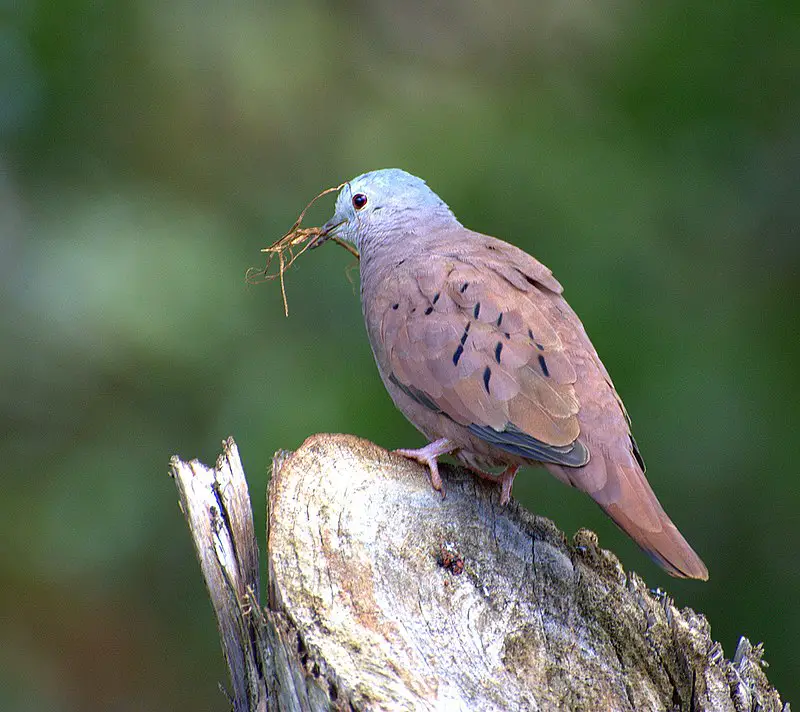
The Ruddy Ground Dove is a small New World tropical bird, found across Mexico and South America as far south as Argentina. It is also seen in the southwestern United States during winter months.
This ground dove typically lives in scrub or other open habitats such as savannas and grasslands, where it feeds on seeds from plants like cactus fruits.
Its plumage ranges from grey to reddish-brown with a light tan breast and black markings throughout its wings and tail feathers.
The male has more distinguishable colouration than the female but both sexes have bright red eyes which give this species its name – ‘ruddy’.
They are often observed perching low to the ground near food sources or nesting sites while also being quite vocal when flying between locations making them easier to spot.
Scientific classification:
| Kingdom | Animalia |
| Phylum | Chordata |
| Class | Aves |
| Order | Columbiformes |
| Family | Columbidae |
| Genus | Columbina |
| Species | C. talpacoti |
9. Savanna Hawk
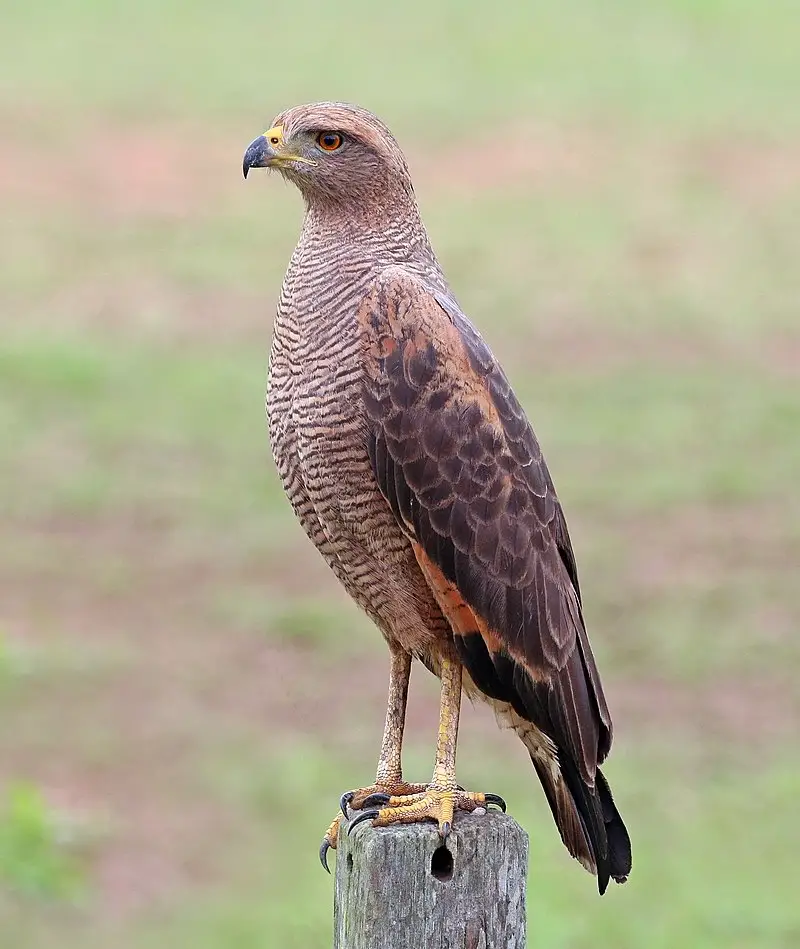
The Savanna Hawk is a large raptor found mainly in open savannas and swamp edges, ranging from Panama to Bolivia. It has an unmistakable rufous body with grey mottling above and fine black barring below.
Its length ranges between 46-61 cm (18-24 inches) with a weight of 845g (29.8oz).
These birds are fierce hunters who feed on small mammals, reptiles, amphibians or insects which they capture during flight using their powerful talons or beak.
They build nests high up in trees preferably along the edge of forests where they can spot prey easily over long distances due to their excellent vision capabilities.
The Savanna Hawk is known for its loud calls that echo through the skies as it soars across the landscape looking for its next meal.
Scientific classification:
| Kingdom | Animalia |
| Phylum | Chordata |
| Class | Aves |
| Order | Accipitriformes |
| Family | Accipitridae |
| Genus | Buteogallus |
| Species | B. meridionalis |
10. Green-Rumped Parrotlet
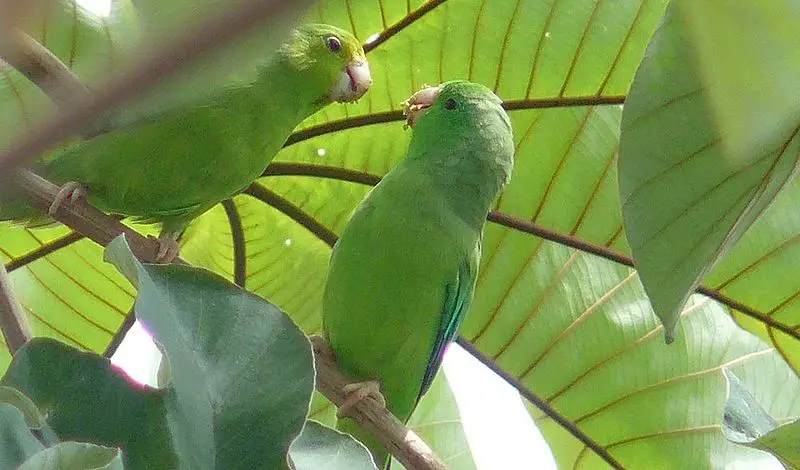
The green-rumped parrotlet is a vibrant species of small parrot native to northeastern South America.
It has a bright green body, with lighter shades on its forehead, cheeks and underparts.
The males feature dark blue patches on their wings while the females have brighter greens in these areas.
These birds are found throughout northern Venezuela eastwards towards the lower Amazon region in Brazil.
They prefer humid tropical forests but can also be seen near urban environments or agricultural land where they search for food such as fruits and seeds from plants and trees nearby.
Green-rumped parrotlets form long-term pair bonds between mates and build cup shaped nests which they line up with feathers that were plucked off their own bodies.
Scientific classification:
| Kingdom | Animalia |
| Phylum | Chordata |
| Class | Aves |
| Order | Psittaciformes |
| Family | Psittacidae |
| Genus | Forpus |
| Species | F. passerinus |
11. Collared Trogon
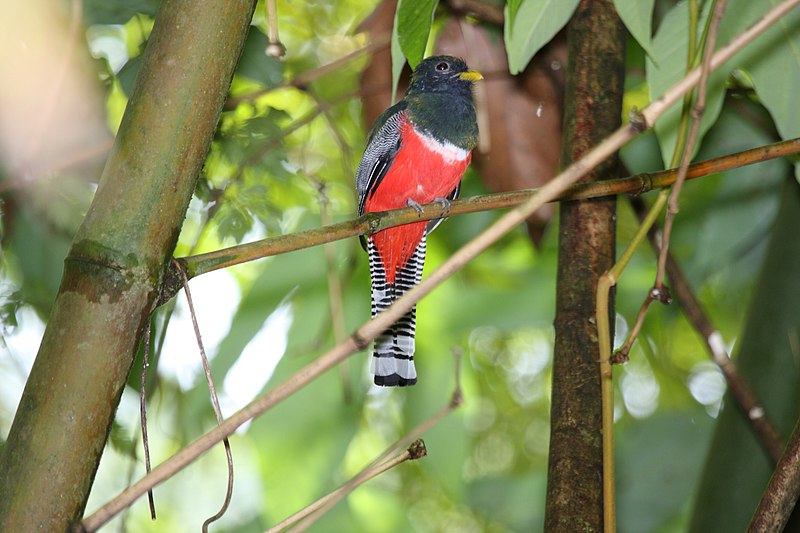
The Collared Trogon is a beautiful bird found in Mexico, Central America and northern South America. It belongs to the family of quetzals and trogons.
The International Ornithological Committee (IOC) recognizes 10 subspecies of this species, with one being called orange-bellied trogon due to its bright belly feathers.
Its plumage features colors such as iridescent greens, blues, yellows and blacks that create an attractive pattern on their wings when they take flight from branch to branch searching for food.
They primarily eat fruits but also consume insects small lizards or frogs occasionally for extra sustenance if needed.
A great majority are sedentary non migrant birds however some will travel short distances during specific periods of the year depending on where they live geographically speaking All in all these amazing creatures make a wonderful addition to any wildlife scene.
Scientific classification:
| Kingdom | Animalia |
| Phylum | Chordata |
| Class | Aves |
| Order | Trogoniformes |
| Family | Trogonidae |
| Genus | Trogon |
| Species | T. collaris |
12. Motmot
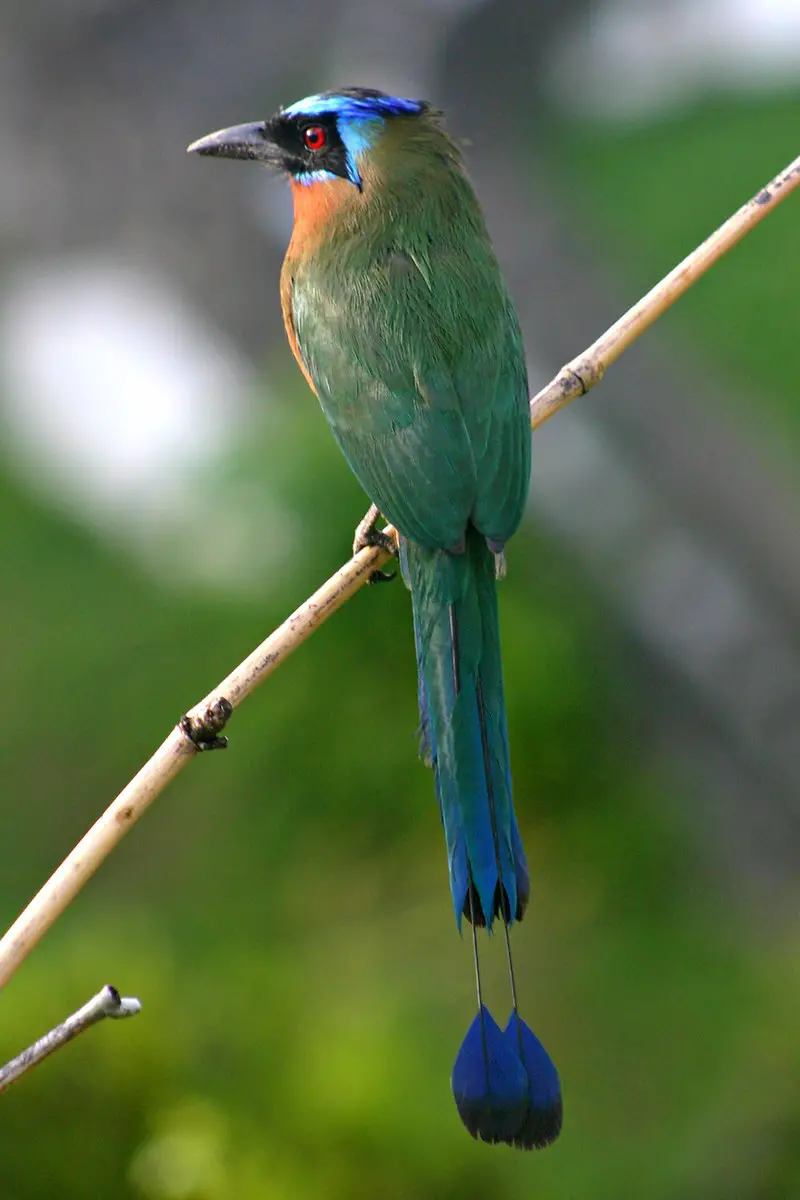
Motmots are a family of birds in the order Coraciiformes, known for their vibrant plumage and relatively heavy bills. They inhabit woodlands or forests across the Neotropics and can range in size from small to large.
The most distinctive feature of motmot species is their long tail feathers that some have adorned with unique patterns like eyespots.
Their diet consists mainly of insects but they will also eat smaller vertebrates such as lizards, frogs and fish.
Motmots are active during daylight hours where they can be seen perching on branches along forest edges or flitting through trees hunting prey.
These beautiful creatures have become an important part of many peoples’ lives throughout Latin America due to them being considered symbols of good luck by local cultures.
Scientific classification:
| Kingdom | Animalia |
| Phylum | Chordata |
| Class | Aves |
| Order | Coraciiformes |
| Family | Momotidae GR Gray, 1840 |
13. Blue-And-Yellow Macaw
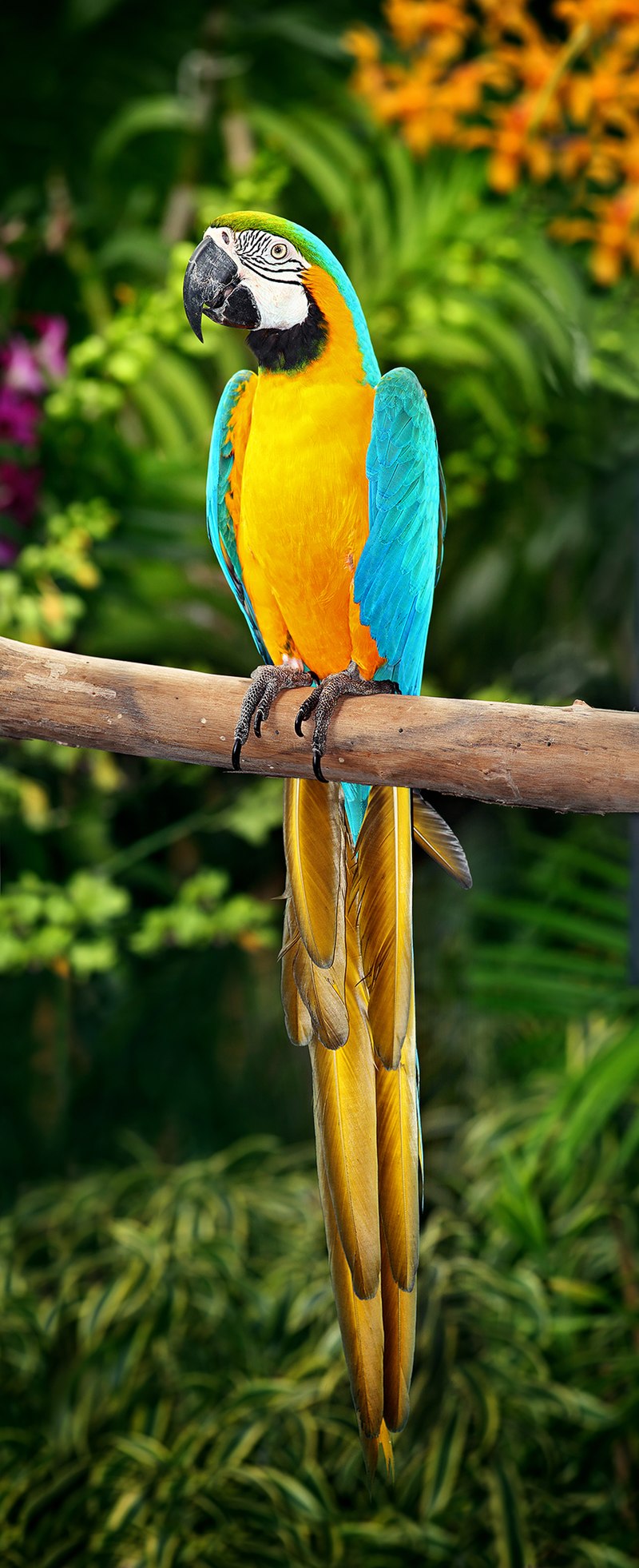
The Blue-and-yellow Macaw is a vibrant and eye catching bird native to South America. It has beautiful blue top parts, light orange underparts, and green on its head.
This large parrot lives in the tropical forests of varzea, terra firme or unflooded forest areas.
They are social birds that live in small flocks which can range from two to twenty birds during breeding season when they look for mates.
They feed mainly on seeds, nuts and fruits but sometimes also eat insects like beetles and caterpillars as well as tender shoots from trees & plants.
These macaws have an impressive call with loud screams used both to attract mates and communicate between members of their flock while flying long distances across open fields together.
Scientific classification:
| Kingdom | Animalia |
| Phylum | Chordata |
| Class | Aves |
| Order | Psittaciformes |
| Family | Psittacidae |
| Genus | Ara |
| Species | A. ararauna |
14. Orange-Winged Amazon
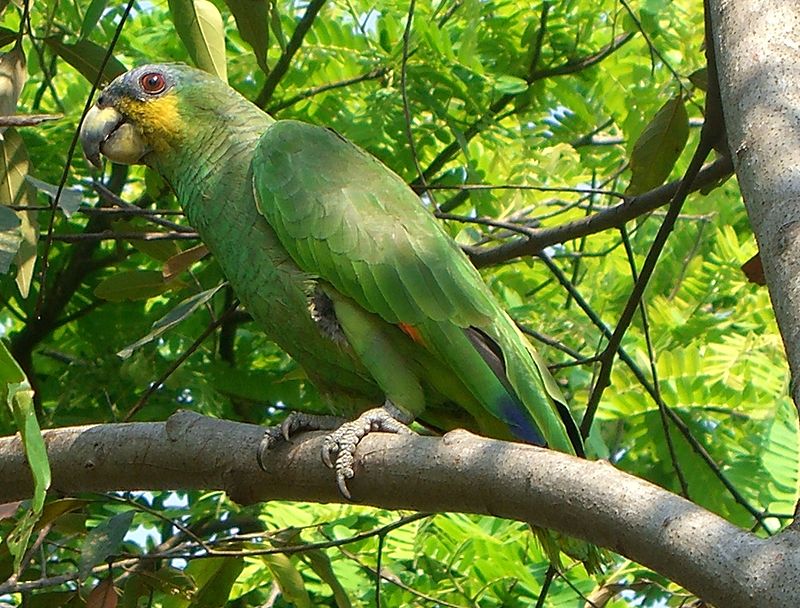
The orange-winged amazon is a vibrant and large parrot native to South America. Its habitat consists of both tropical forests and semi-open country areas, spanning from Colombia, Trinidad & Tobago down to Peru, Bolivia and central Brazil.
Although its population seems healthy at the moment due to its wide range throughout these countries, it still suffers persecution as an agricultural pest as well as capture for the pet trade industry.
It has striking features that make it easily distinguishable; namely bright red feathers on its forehead along with yellowish-orange wings which give this bird its name.
With proper protection against poaching and hunting by humans in place they should remain a colorful addition to our planet’s avian family.
Scientific classification:
| Kingdom | Animalia |
| Phylum | Chordata |
| Class | Aves |
| Order | Psittaciformes |
| Family | Psittacidae |
| Genus | Amazona |
| Species | A. amazonica |
Also Featured In: Rainforest Birds You Should Know, Green Birds Commonly Found in Florida
15. Smooth-Billed Ani
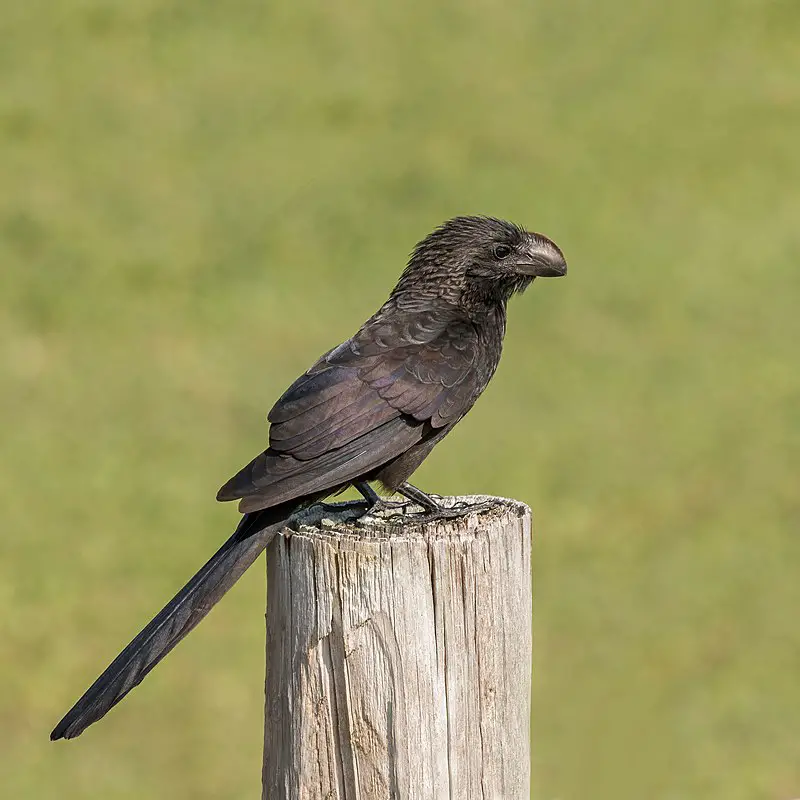
The Smooth-billed Ani is a species of bird in the cuckoo family, native to regions spanning from southern Florida and the Caribbean down through Central America, South America, and parts of Argentina.
They have even been introduced to Galapagos around 1960s where they may be impacting local wildlife due to their aggressive nature.
As its name suggests, these birds have smooth bills which are adapted for feeding on hard fruits or other items such as insects and lizards that it finds while scavenging around trees or ground level vegetation.
They usually form small flocks when out searching for food with males being slightly larger than females.
Overall this adaptable species is found in many habitats across its broad range but does best at low elevation open areas near water sources like marshes or swamps making them easier targets for human disturbance as well.
Scientific classification:
| Kingdom | Animalia |
| Phylum | Chordata |
| Class | Aves |
| Order | Cuculiformes |
| Family | Cuculidae |
| Genus | Crotophaga |
| Species | C. ani |
16. Blue-Gray Tanager
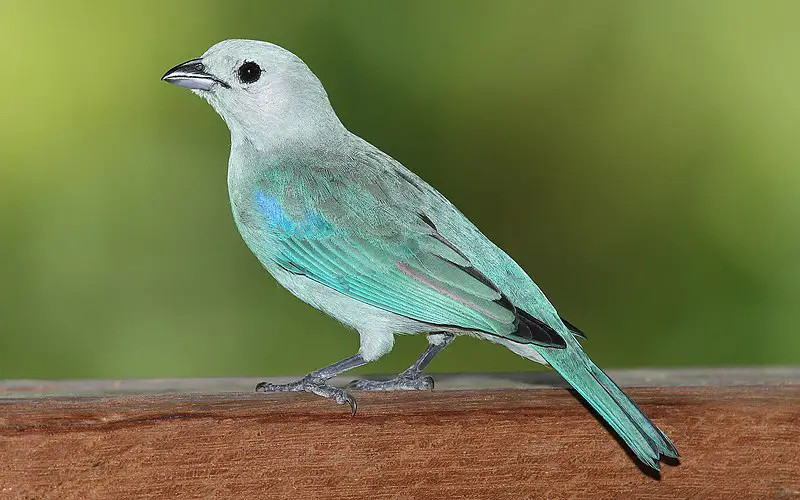
The blue-gray tanager is a medium-sized songbird native to South America, ranging from Mexico all the way down to northern Brazil and Bolivia.
It has been introduced in Lima, Peru as well as Trinidad and Tobago where it is called “blue jean”.
This species was first described by French zoologist Mathurin Jacques Brisson in 1760. The bird’s plumage features hues of gray, blue, yellow and green creating an attractive contrast against its white belly.
Its diet consists mainly of insects like beetles but also fruits such as figs are known to be part of their daily nutrition.
Blue-gray tanagers usually inhabit humid forests near running watercourses making them relatively easy to spot while they search for food on tree branches or foliage cover around streams during the day time.
Scientific classification:
| Kingdom | Animalia |
| Phylum | Chordata |
| Class | Aves |
| Order | Passeriformes |
| Family | Thraupidae |
| Genus | Thraupis |
| Species | T. episcopus |
17. Boat-Billed Heron
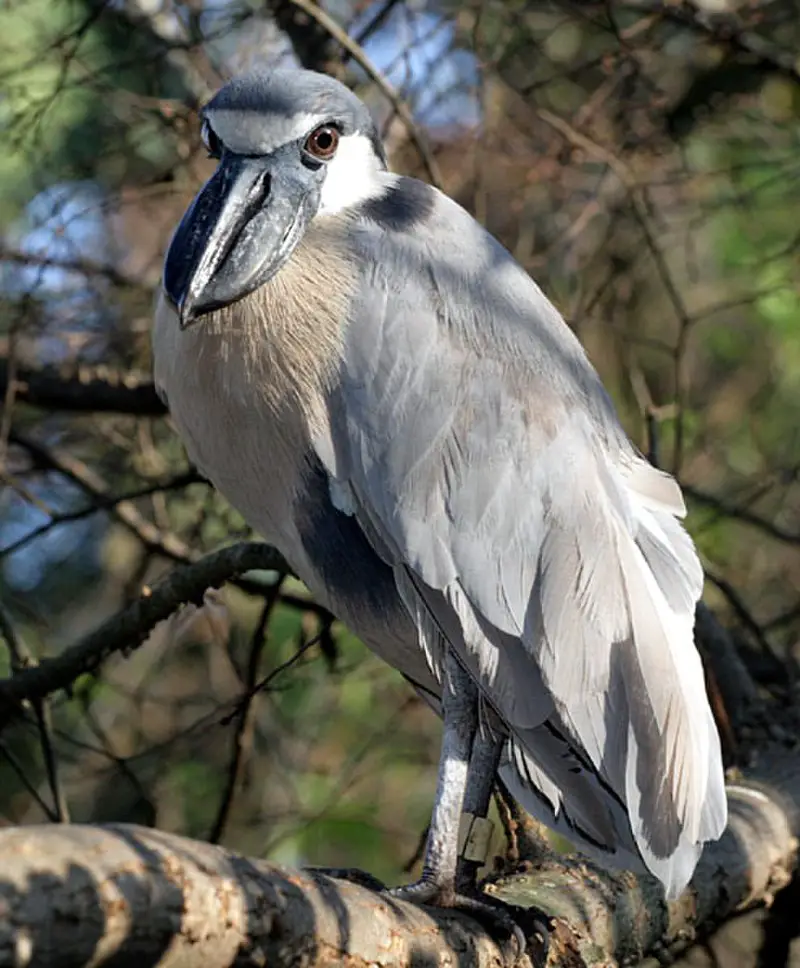
The Boat-billed Heron is a unique member of the heron family, living in mangrove swamps from Mexico to Peru and Brazil. It has an atypical bill shape compared to other members of its family which gives it its name.
Due to its nocturnal behavior, this bird breeds semi-colonially in mangrove trees during the night and lays two to four blue eggs per clutch that take around three weeks for incubation.
This species also exhibits some interesting hunting techniques such as spreading out its wings while standing still on branches or even submerging itself partially into water until prey passes by within reach; so they can snatch them quickly with their long beaks.
Conservation efforts must continue due to threats posed by habitat loss and human disturbance.
Scientific classification:
| Kingdom | Animalia |
| Phylum | Chordata |
| Class | Aves |
| Order | Pelecaniformes |
| Family | Ardeidae |
| Subfamily | Tigriornithinae |
| Genus | Cochlearius Brisson, 1760 |
| Species | C. cochlearius |
18. Black Hawk-Eagle
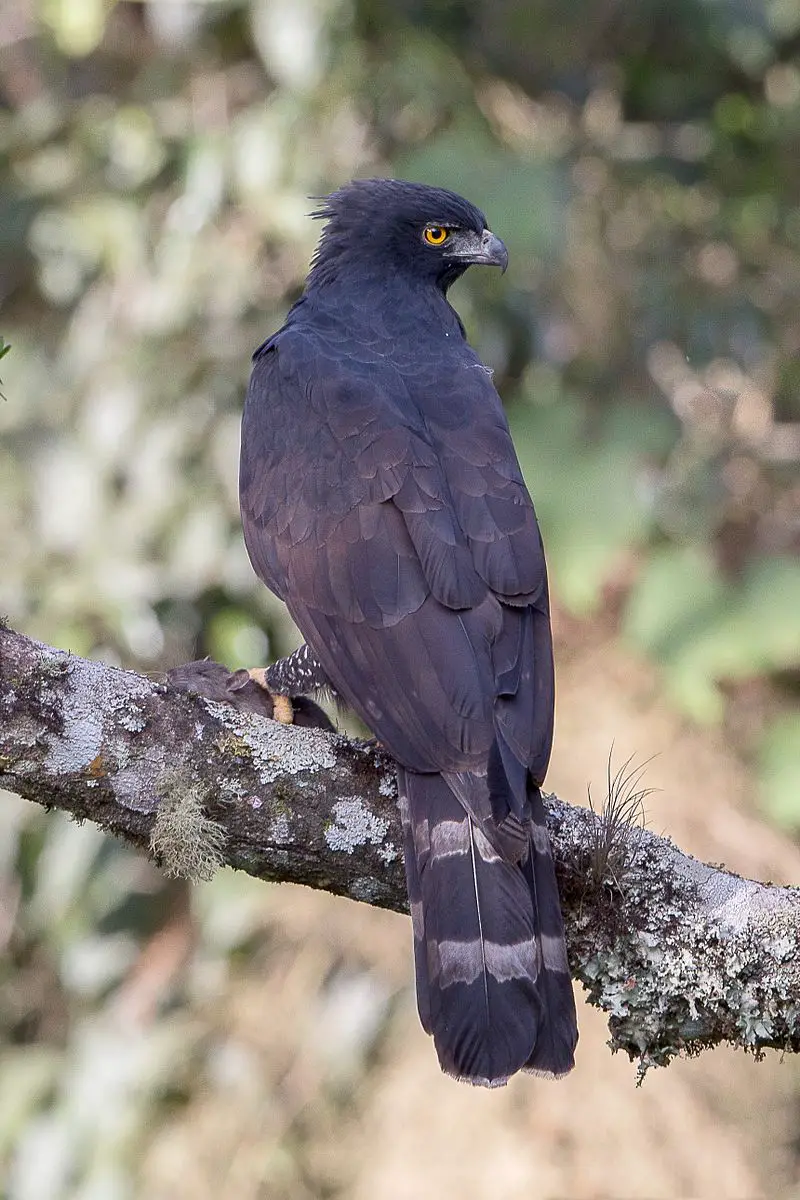
The Black Hawk-Eagle is a majestic bird of prey found throughout Central and South America. With its striking black plumage and distinctive white wing patches, this large eagle can soar gracefully in the air with ease.
It has two known subspecies: S.t tyrannus which is mostly found in Brazil and Argentina, while S. t serus inhabits other parts of Latin America such as Mexico to Colombia, eastern Peru, northern Argentina among others regions.
This beautiful raptor feeds mainly on small mammals like hares or birds but also enjoys carrion when available – it’s an opportunistic hunter that takes advantage of any food sources within reach.
The Black Hawk-Eagle plays an important role in many local ecosystems by controlling animal populations through predation yet they remain vulnerable due to habitat destruction from human activities such as urban expansion or unsustainable agricultural practices .
Scientific classification:
| Kingdom | Animalia |
| Phylum | Chordata |
| Class | Aves |
| Order | Accipitriformes |
| Family | Accipitridae |
| Genus | Spizaetus |
| Species | S. tyrannus |
19. Agami Heron
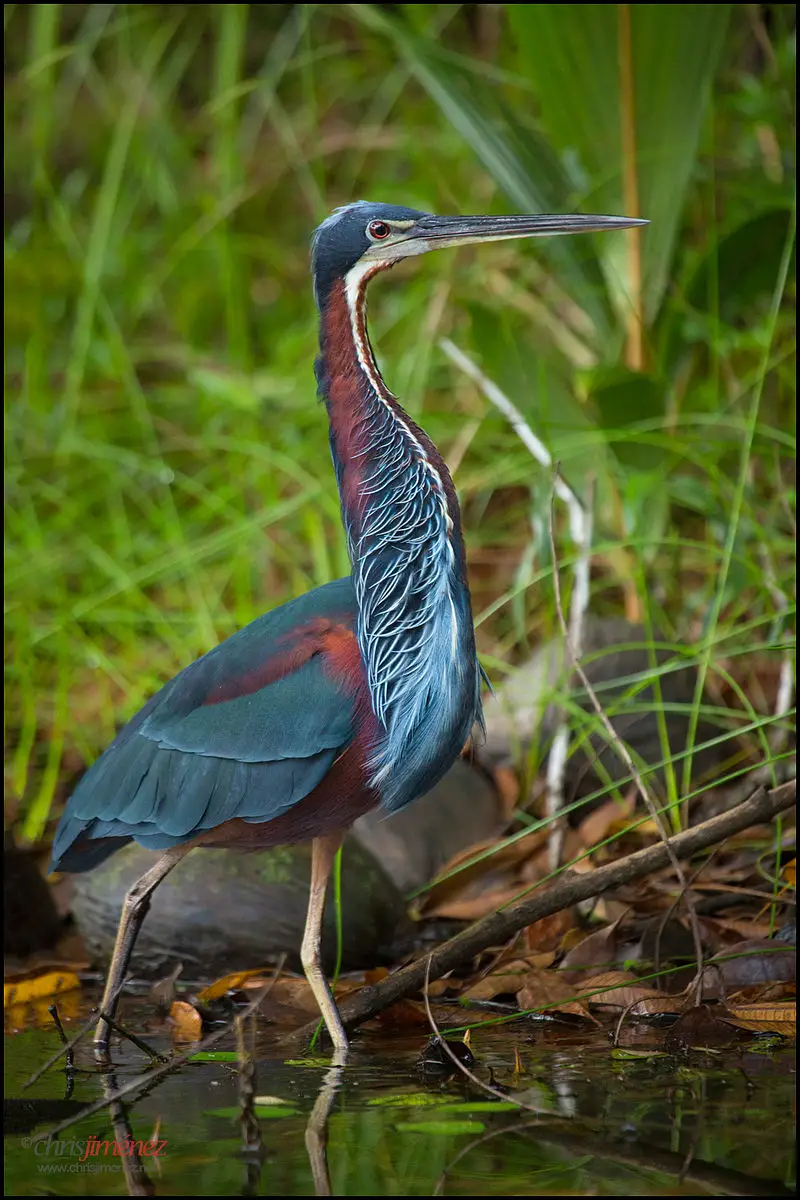
The Agami Heron is a medium-sized heron with unique features. It can be found in Central America all the way to Peru and Brazil, where it is sometimes referred to as Soco Beija-Flor or ‘Hummingbird Heron’ due to its colorful appearance.
This species of bird has been classified as vulnerable by The IUCN Red List of Threatened Species mainly because of the destruction of its wetland habitats from human activity such as agriculture, pollution and overfishing.
As a result, conservation efforts are being taken worldwide for this beautiful creature so that future generations will have an opportunity to enjoy their presence in our environment.
With proper management we can ensure that these birds remain safe and plentiful into the future.
Scientific classification:
| Kingdom | Animalia |
| Phylum | Chordata |
| Class | Aves |
| Order | Pelecaniformes |
| Family | Ardeidae |
| Subfamily | Ardeinae |
| Genus | Agamia Reichenbach, 1853 |
| Species | A. agami |
20. Blue-Tailed Emerald
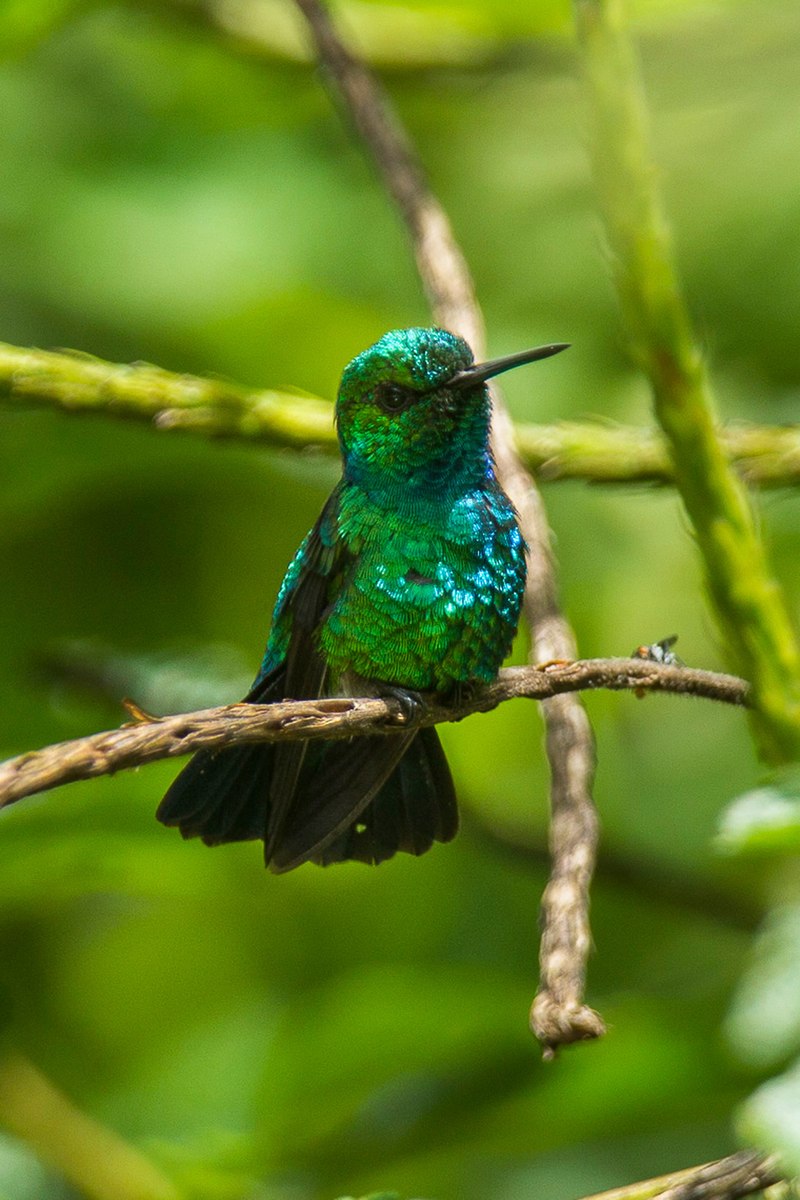
The Blue-tailed Emerald is a beautiful and vibrant hummingbird that is found in tropical and subtropical parts of South America. This species has bright green feathers, with the male having an iridescent blue tail.
These birds can be seen foraging among small flowers to collect nectar or catching insects on the wing. They are considered one of the smallest bird species, measuring at around 4 inches long from head to tail tip.
The Blue-tailed Emerald lives primarily east of the Andes Mountains from Colombia down through northern Bolivia and central Brazil, as well as Trinidad and other areas within its range such as Guianas.
It was first described by Swedish naturalist Carl Linnaeus in 1758 who noted its unique beauty compared to other birds.
Scientific classification:
| Kingdom | Animalia |
| Phylum | Chordata |
| Class | Aves |
| Order | Apodiformes |
| Family | Trochilidae |
| Genus | Chlorostilbon |
| Species | C. mellisugus |
21. Lineated Woodpecker
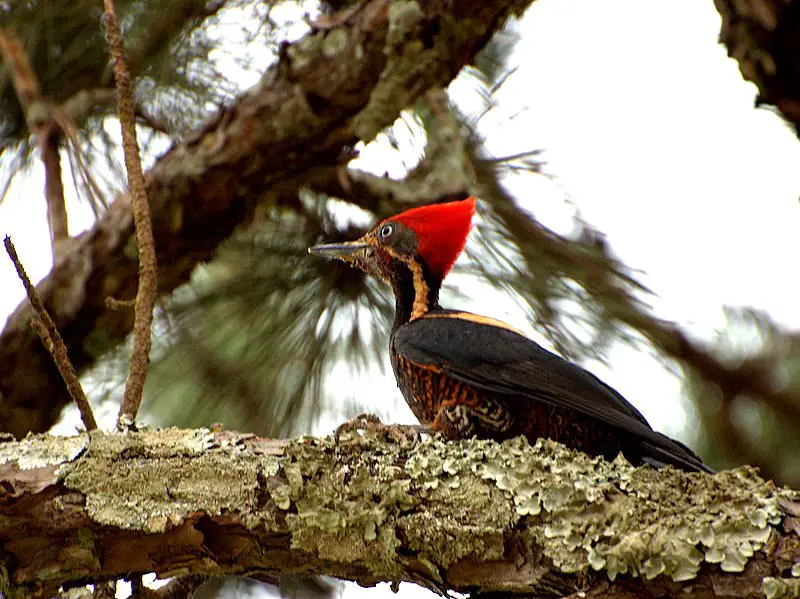
The Lineated Woodpecker is a large bird found in Mexico, Argentina and the Caribbean. It was first described by French zoologist Mathurin Jacques Brisson in 1760 with the name Le pic noir.
This species has black upperparts, wings and tail with white stripes running along its back and head; it also features red marks on its forehead as well as on both sides of its neck.
Its underparts are mostly greyish-white while its bill is yellowish-black and slightly hooked at the end.
These birds feed mainly on insects but can sometimes be seen foraging for fruits or tree sap too.
They nest inside cavities usually made from dead trees which they excavate themselves using their strong bills perfect for drilling into woody material easily.
All in all, these beautiful birds make an interesting addition to any backyard garden.
Scientific classification:
| Kingdom | Animalia |
| Phylum | Chordata |
| Class | Aves |
| Order | Piciformes |
| Family | Picidae |
| Genus | Dryocopus |
| Species | D. lineatus |
22. Guianan Trogon
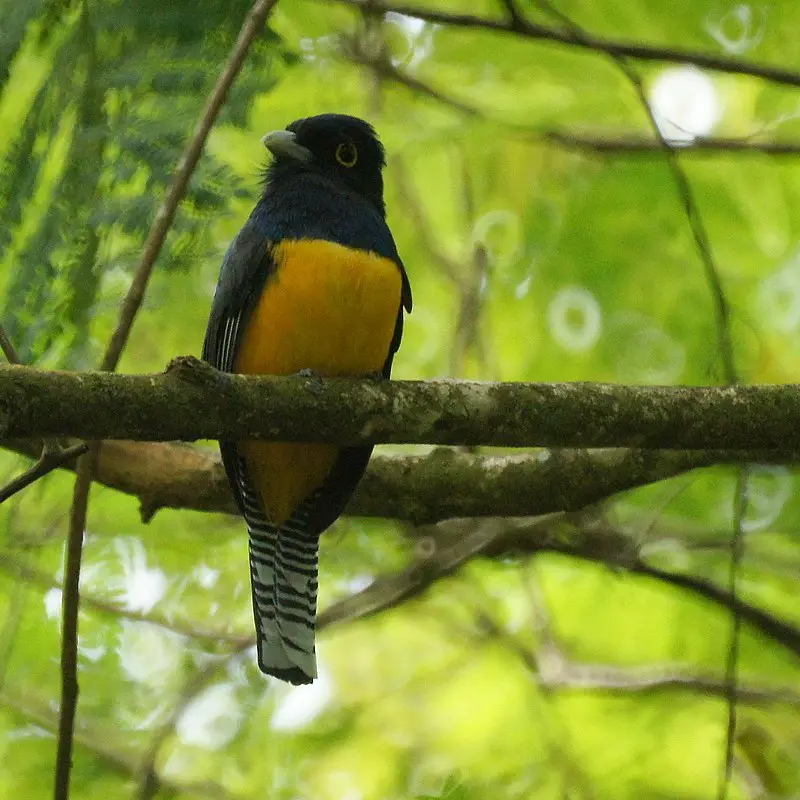
The Guianan trogon is a beautiful near passerine bird found in South America. It belongs to the family Trogonidae alongside quetzals and other trogons, with its vibrant colours making it distinctive from others of its kind.
Its body has a green back, violet wings and tail feathers as well as striking yellow underparts. The head features an eye-catching black band on top of white stripes that run down either side towards the beak.
These birds are typically seen alone or in pairs foraging for food among trees at low heights close to rivers or humid forest areas.
They feed mainly on fruits but also insects sometimes too which they catch mid-flight. All in all, this amazing species is truly one of nature’s wonders.
Scientific classification:
| Kingdom | Animalia |
| Phylum | Chordata |
| Class | Aves |
| Order | Trogoniformes |
| Family | Trogonidae |
| Genus | Trogon |
| Species | T. violaceus |
23. Blue-Backed Manakin
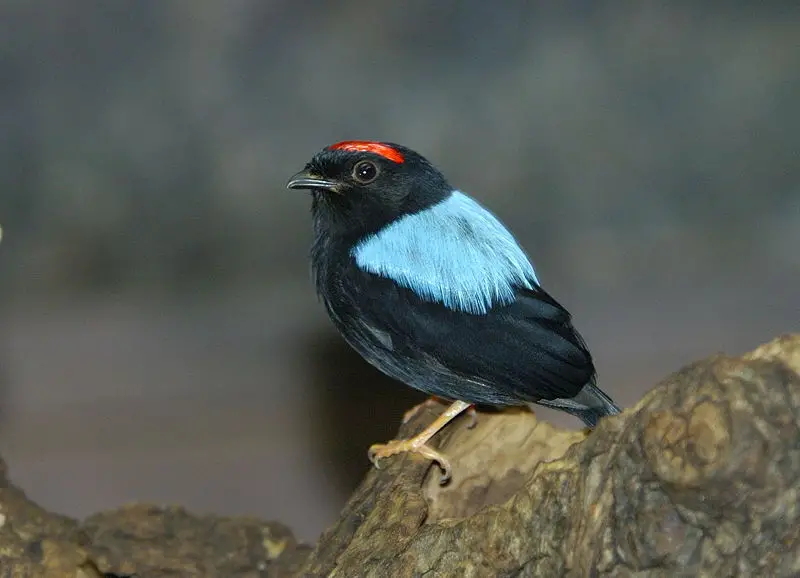
The Blue-backed Manakin is a small passerine bird found in tropical South America. It has an unmistakable plumage, with males having black plumage and bright blue backs contrasted by red or yellow crowns.
Females and juveniles are largely greyish brown above with paler underparts. They typically measure 13cm long making them one of the smallest members of their family.
The species can be found in deciduous forests but not evergreen rainforests, foraging on insects as part of their diet which they catch using sallies from perches up to 4m high.
Despite its vivid colours it is often inconspicuous due to its habit of staying close to cover while feeding or during rest periods; engaging displays such as wing fluttering are only shown when actively courting potential mates.
Scientific classification:
| Kingdom | Animalia |
| Phylum | Chordata |
| Class | Aves |
| Order | Passeriformes |
| Family | Pipridae |
| Genus | Chiroxiphia |
| Species | C. pareola |
24. Yellow-Headed Caracara
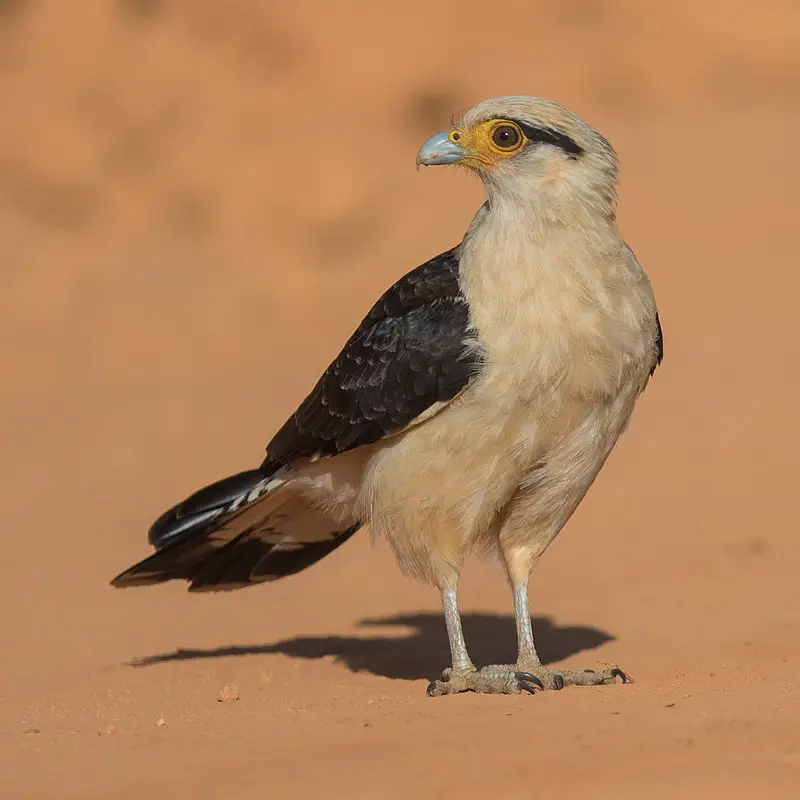
The Yellow-headed Caracara is a majestic bird of prey belonging to the Falconidae family, found in tropical and subtropical South America and southern parts of Central America.
It has an unmistakable bright yellow head that sets it apart from other birds. Unlike its cousins who specialize in fast aerial hunting, the caracara feeds on scavenged food such as dead animals or eggs instead.
Louis Jean Pierre Vieillot first described this species when he discovered them back in 1817. The size varies between 33 cm – 45 cm with wingspan ranging up to 90 cm long.
These stunning birds have a unique red face mask along with black & white plumage across their body which makes them very distinctive looking creatures indeed.
Scientific classification:
| Kingdom | Animalia |
| Phylum | Chordata |
| Class | Aves |
| Order | Falconiformes |
| Family | Falconidae |
| Genus | Milvago |
| Species | M. chimachima |
25. White-Chested Emerald
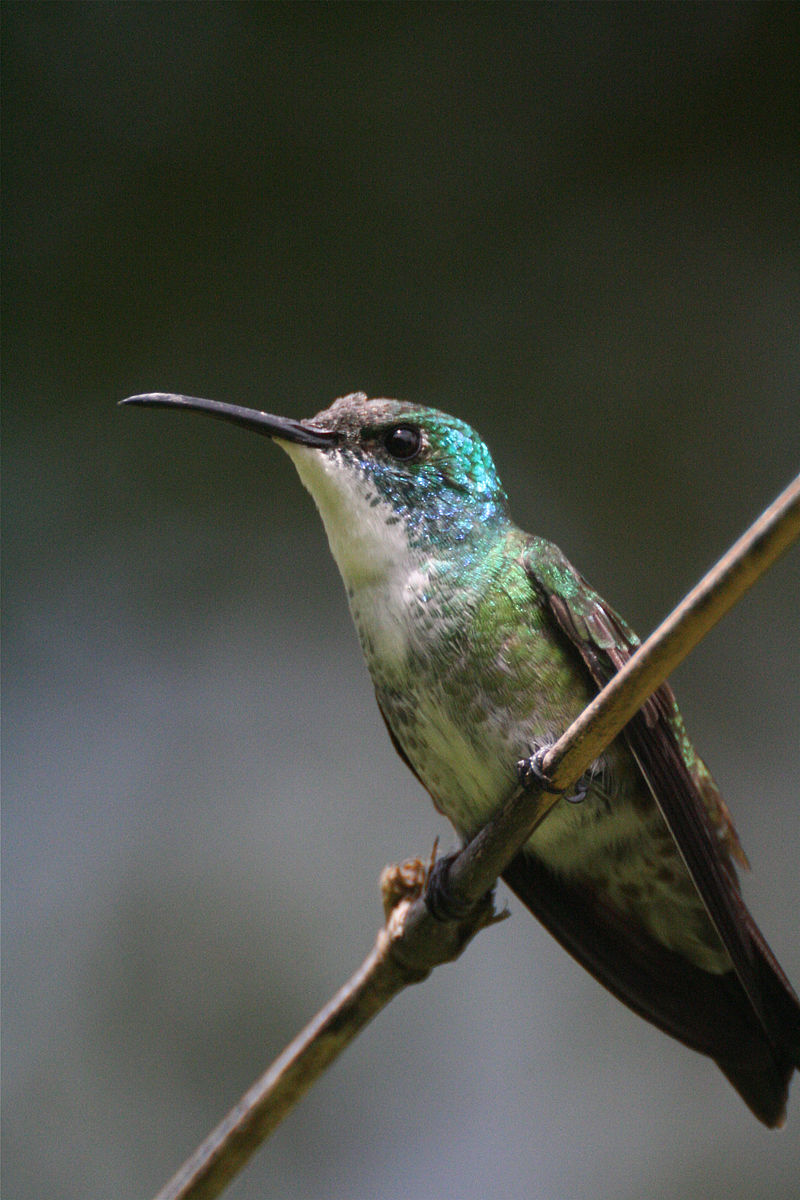
The White-chested Emerald is a vibrant and beautiful bird, belonging to the Trochilini tribe of hummingbirds. It is found in Brazil, Guianas, Trinidad and Venezuela.
This species was previously known as Amazilia chionopectus, Agyrtria brevirostris and then finally Amazilia brevirostris.
A molecular phylogenetic study conducted by Burney et al., 2016 has classified this species into Chrysuronia genus along with other related emeralds like Green-tailed Goldenthroat from South America; hence its current scientific name: Chrysuronia Brevirostris .
They have an average length of about 11 cm long with white chested green body feathers making them look very attractive when they fly around.
Scientific classification:
| Kingdom | Animalia |
| Phylum | Chordata |
| Class | Aves |
| Order | Apodiformes |
| Family | Trochilidae |
| Genus | Chrysuronia |
| Species | C. brevirostris |
26. Blue-Headed Parrot
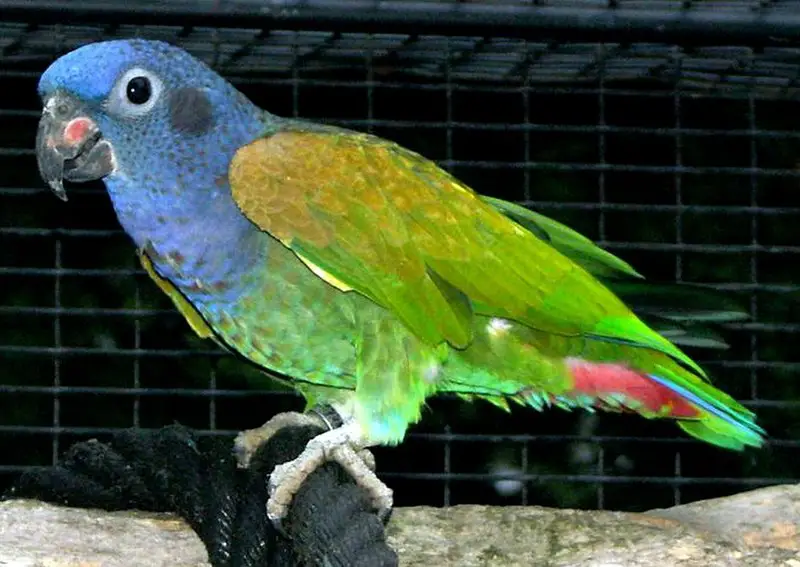
The Blue-headed Parrot is a stunning bird native to South and Central America. It measures around 27 cm in length, with its body mostly green, blue head and neck, and red undertail coverts.
This beautiful parrot lives in tropical or subtropical forests as well as savannas where it feeds on fruits such as figs, nuts and mangos.
In the wild they are often seen flying in small groups of up to 10 birds that chatter loudly.
They make excellent pets too due to their intelligence but require lots of attention from owners who should provide plenty of toys for them so they don’t get bored.
All in all these amazing creatures will bring joy into any home or garden.
Scientific classification:
| Kingdom | Animalia |
| Phylum | Chordata |
| Class | Aves |
| Order | Psittaciformes |
| Family | Psittacidae |
| Genus | Pionus |
| Species | P. menstruus |
27. Rufous-Breasted Hermit
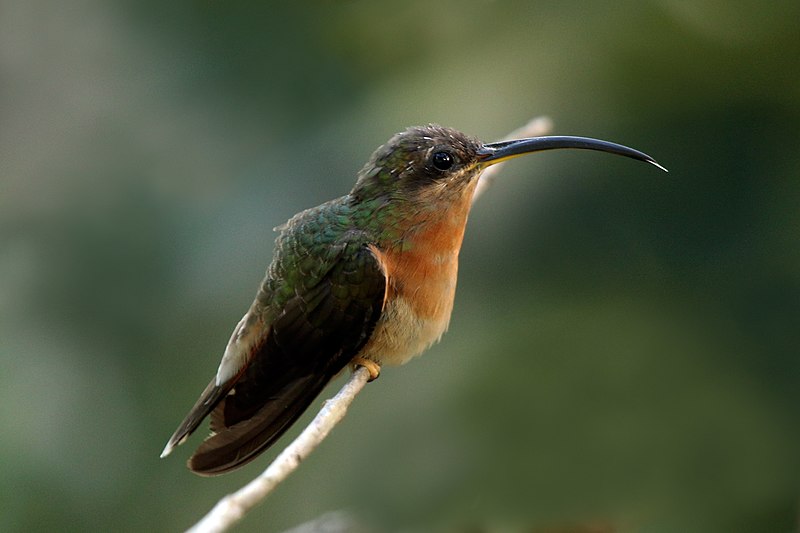
The Rufous-breasted Hermit is a small hummingbird, native to Central and South America.
It has rufous underparts with white spots on the sides of its chest, as well as long tail feathers which are brown above and white below.
This species is generally widespread, though some local populations may fluctuate in numbers due to changes in habitat conditions.
They breed during the months from March until August, typically constructing their nests low down among dense vegetation or near water sources such as rivers or streams.
These birds are very active feeders that dart rapidly between flowers for nectar while also consuming insects for protein throughout the day – making them an important part of any natural ecosystem.
Scientific classification:
| Kingdom | Animalia |
| Phylum | Chordata |
| Class | Aves |
| Order | Apodiformes |
| Family | Trochilidae |
| Genus | Glaucis |
| Species | G. hirsutus |
28. Brown Violetear
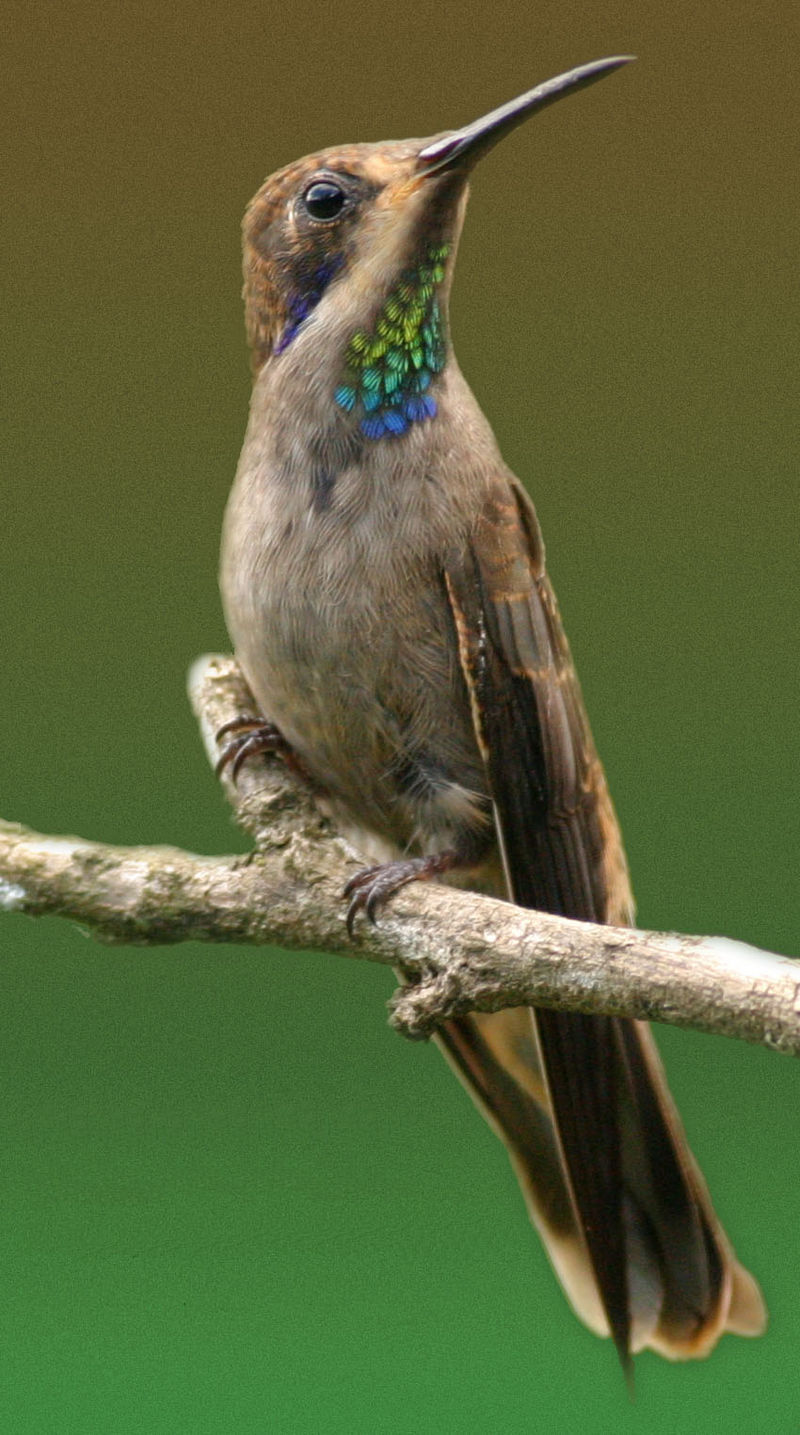
The Brown Violetear is a spectacular hummingbird, renowned for its beautiful plumage and wingspan of up to 4 inches. It can be found in Central America, the Andes region and northern South America including Trinidad and Brazil’s Bahia state.
Favoring middle elevations between 400-1600m, this species nests in forests characterized by lush vegetation.
During mating season males are adorned with conspicuous violet feathers on their ears which give them their name ‘Violetear’. The birds feed mainly from nectar rich flowers like lantana camara or banana trees.
Their diet also consists of small insects such as fruit flies that provide necessary proteins for energy needs during flight.
With a lifespan of around 5 years these amazing creatures bring joy to many birdwatchers who travel far just to catch sight of them.
Scientific classification:
| Kingdom | Animalia |
| Phylum | Chordata |
| Class | Aves |
| Order | Apodiformes |
| Family | Trochilidae |
| Genus | Colibri |
| Species | C. delphinae |
29. Nacunda Nighthawk
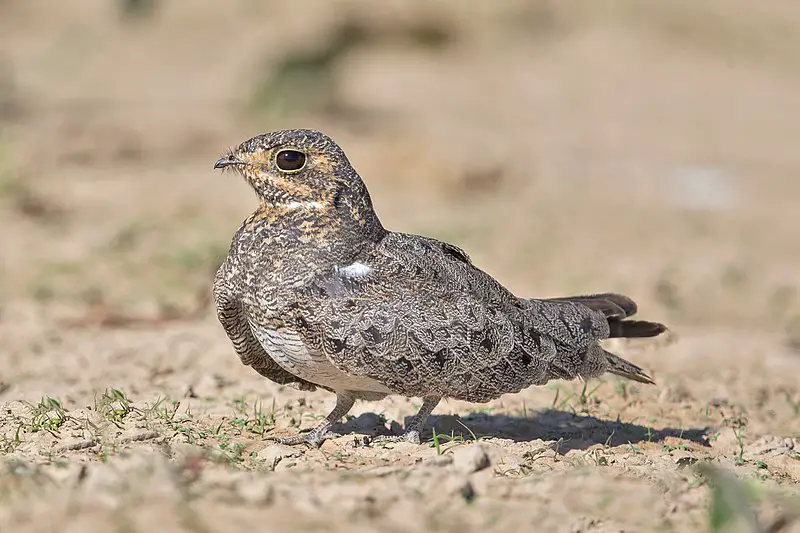
The Nacunda nighthawk is a species of nightjar belonging to the family Caprimulgidae. It can be found in South America, extending from Argentina and Bolivia to Venezuela and Trinidad & Tobago.
These birds prefer dry savannas or grasslands as their habitat but are also accustomed to heavily degraded areas once used for forestry purposes.
They feed on moths, beetles and other insects that they catch while flying at dusk or dawn near rivers or lakes.
The typical plumage consists of gray-brown upperparts with white spots across its wings and tail feathers; breast has black streaks running down it whereas its belly is usually whitish in colouration.
Despite being well studied, there isn’t much known about this bird’s breeding behaviour as nesting sites have rarely been observed due to them being hidden away within dense vegetation surrounding wetlands or flooded forests .
Scientific classification:
| Kingdom | Animalia |
| Phylum | Chordata |
| Class | Aves |
| Order | Caprimulgiformes |
| Family | Caprimulgidae |
| Genus | Chordeiles |
| Species | C. nacunda |
30. Paint-Billed Crake
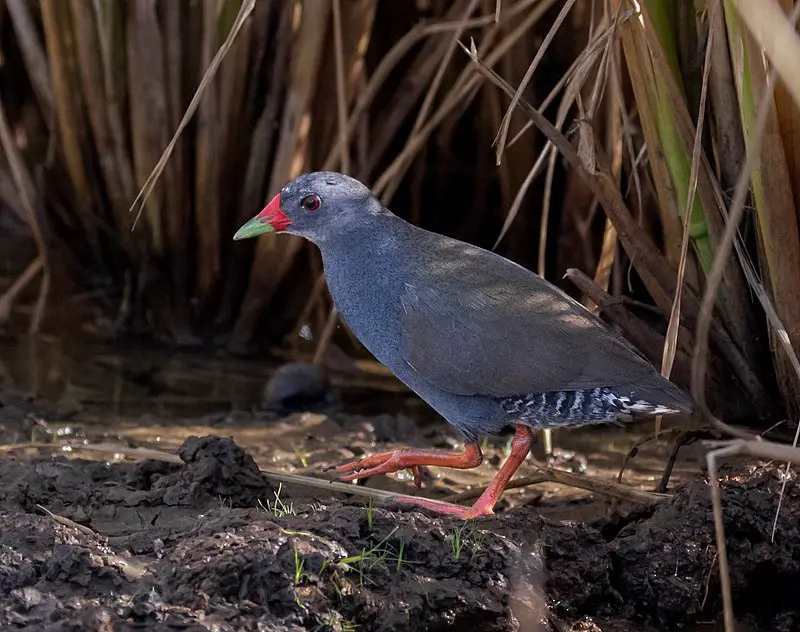
The Paint-billed Crake is a species of bird found in Central and South America, as well as the Galápagos Islands.
This member of the Rallidae family is characterized by its bright red bill and grayish brown plumage with white spots on each individual feather.
It prefers to stay hidden amongst dense vegetation near fresh water sources such as marshes or swamps, where it feeds mainly on insects and other small invertebrates like snails or molluscs.
Despite being relatively widespread across its range, this species remains elusive due to its secluded nature; making sightings quite rare for human observers.
The genus Neocrex was created specifically to house this remarkable bird.
Scientific classification:
| Kingdom | Animalia |
| Phylum | Chordata |
| Class | Aves |
| Order | Gruiformes |
| Family | Rallidae |
| Genus | Neocrex |
| Species | N. erythrops |
Also Featured In: Most Common Birds in Isabela Island, Birds That Live In Tristan da Cunha
31. Band-Tailed Pigeon
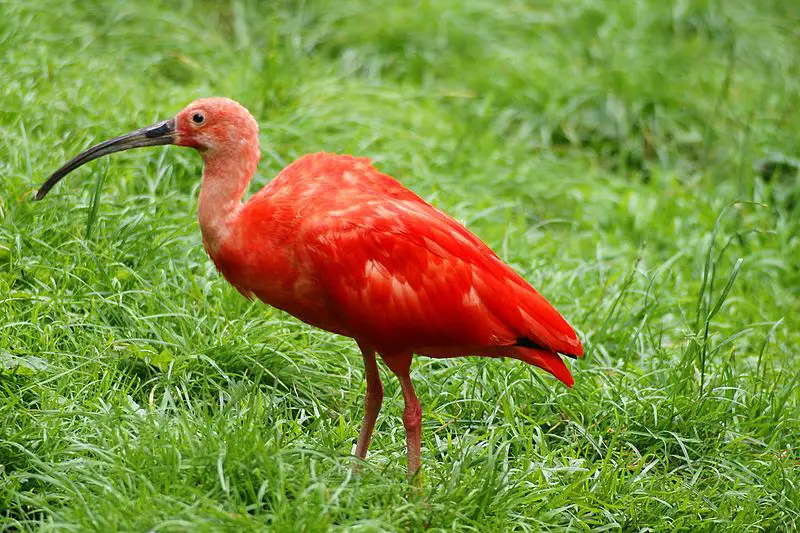
The Band-tailed Pigeon is a large, plump bird with an unmistakable long banded tail. It has mostly grayish plumage and can be found in western North America from Canada to Mexico.
This species primarily lives in forests of oak and conifers near water sources such as rivers or lakes where they feed on acorns, nuts and fruits from trees.
They are known for their cooing calls that echo through the woods.
These birds form huge flocks when migrating which often includes other pigeon species like the White-winged Dove or Mourning Dove.
During breeding season, they will nest high up in tall trees using twigs to build nests usually lined with grasses or feathers.
The female typically lays one white egg per clutch which she incubates alone while being fed by her mate during this time period.
Band-tailed Pigeons play an important role in our ecosystem by dispersing seeds throughout their range thus helping replenish native plants within those areas.
32. Blue-Chinned Sapphire

The Band-tailed Pigeon is a large, plump bird with an unmistakable long banded tail. It has mostly grayish plumage and can be found in western North America from Canada to Mexico.
This species primarily lives in forests of oak and conifers near water sources such as rivers or lakes where they feed on acorns, nuts and fruits from trees.
They are known for their cooing calls that echo through the woods.
These birds form huge flocks when migrating which often includes other pigeon species like the White-winged Dove or Mourning Dove.
During breeding season, they will nest high up in tall trees using twigs to build nests usually lined with grasses or feathers.
The female typically lays one white egg per clutch which she incubates alone while being fed by her mate during this time period.
Band-tailed Pigeons play an important role in our ecosystem by dispersing seeds throughout their range thus helping replenish native plants within those areas.
33. Blue Ground Dove
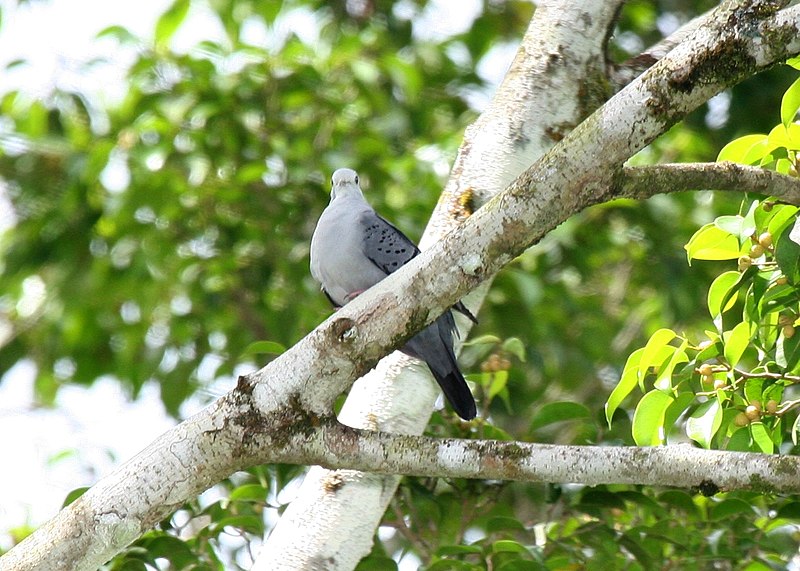
The Blue Ground Dove is a stunningly beautiful bird found in tropical areas of North, Central and South America.
It has an iridescent blue-green back with a gray head and wings, while its breast is pinkish orange in color.
This small dove lives mainly in open woodlands, forest edges, clearings and roadsides – particularly around more humid regions – from sea level to about 1 200 meters altitude.
The species builds cup shaped nests out of twigs which it places on trees or shrubs usually near water sources.
These birds are quite common but their numbers have unfortunately been decreasing due to habitat loss caused by deforestation for agricultural purposes as well as hunting pressure from humans who use them for food or trapping baitbirds.
Scientific classification:
| Kingdom | Animalia |
| Phylum | Chordata |
| Class | Aves |
| Order | Columbiformes |
| Family | Columbidae |
| Genus | Claravis Oberholser, 1899 |
| Species | C. pretiosa |
Also Featured In: Cozumel Birds You Didn’t Know,
34. Rufous-Tailed Jacamar
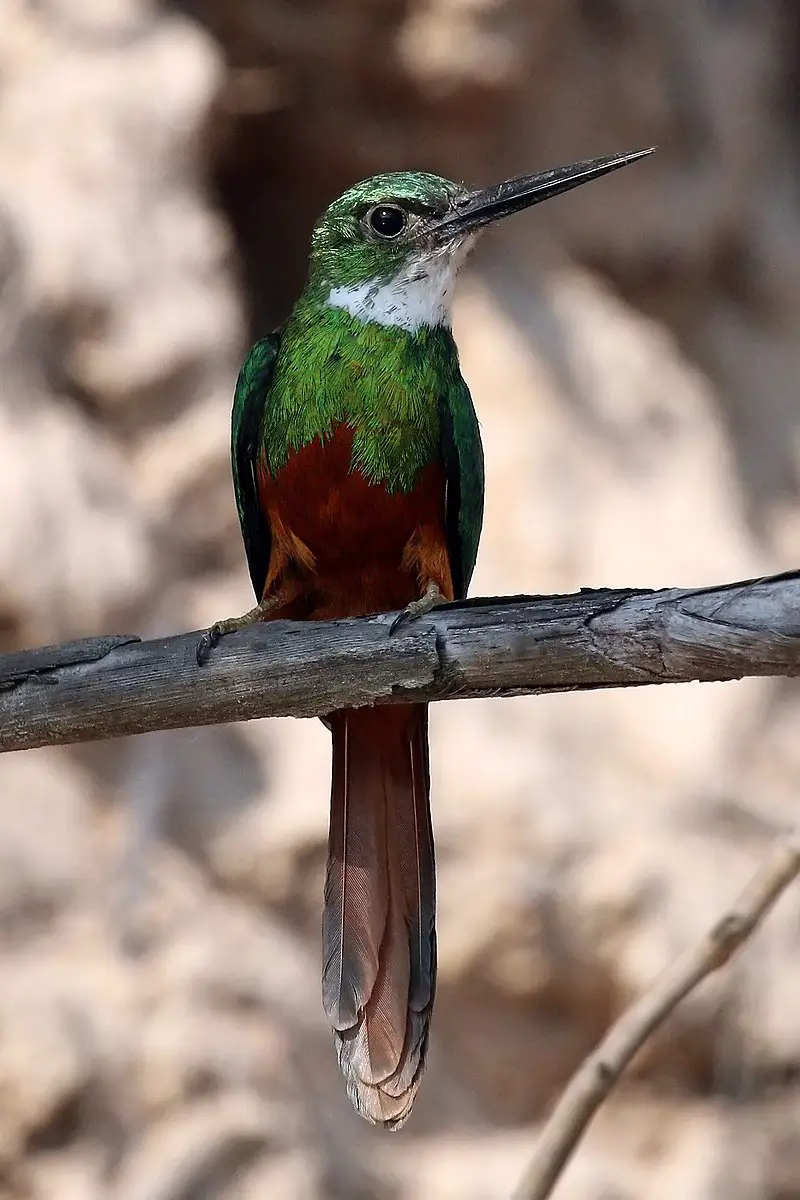
The Rufous-tailed Jacamar is a near-passerine bird that lives in tropical regions of Mexico, Central and South America. It’s about 25 cm long with a 5 cm black bill and its distinguishing feature is its rufous coloured tail feathers.
Its body has an elegant shape with bright plumage consisting of mainly green hues on the head, neck and wings; whilst it’s chest is white with yellow speckles.
These birds feed mostly on insects which they catch midair or from branches using their long bills to pluck them out.
They build nests made from twigs lined by mosses in tree cavities where they lay two eggs at once during breeding season between April – August each year.
Scientific classification:
| Kingdom | Animalia |
| Phylum | Chordata |
| Class | Aves |
| Order | Piciformes |
| Family | Galbulidae |
| Genus | Galbula |
| Species | G. ruficauda |
35. Green Hermit
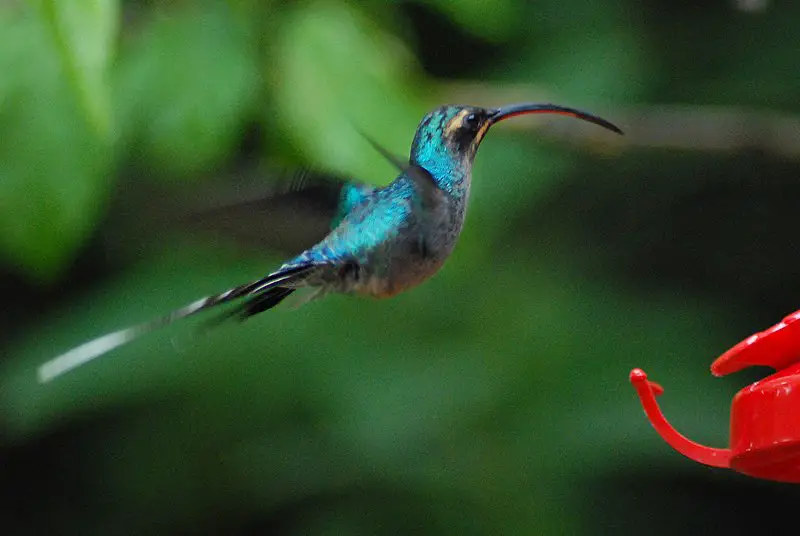
The Green Hermit is a striking bird, measuring 13.5 cm in length and weighing 6.3 grams. It has vibrant green feathers with a blue-green rump, along with dark mask around the eye area that gives it an enigmatic appearance.
This species of hummingbird can be found from southern Central America to northern South America and east Peru’s northern Andes Mountains; they are known as resident breeders there.
Not only does its beautiful plumage make this species stand out amongst other birds but also their unique call which consists of thin high pitched whistles and squeaks.
The Green Hermit truly is a remarkable creature that brings joy to many throughout Central & South American countries.
Scientific classification:
| Kingdom | Animalia |
| Phylum | Chordata |
| Class | Aves |
| Order | Apodiformes |
| Family | Trochilidae |
| Genus | Phaethornis |
| Species | P. guy |
36. Trinidad Piping Guan
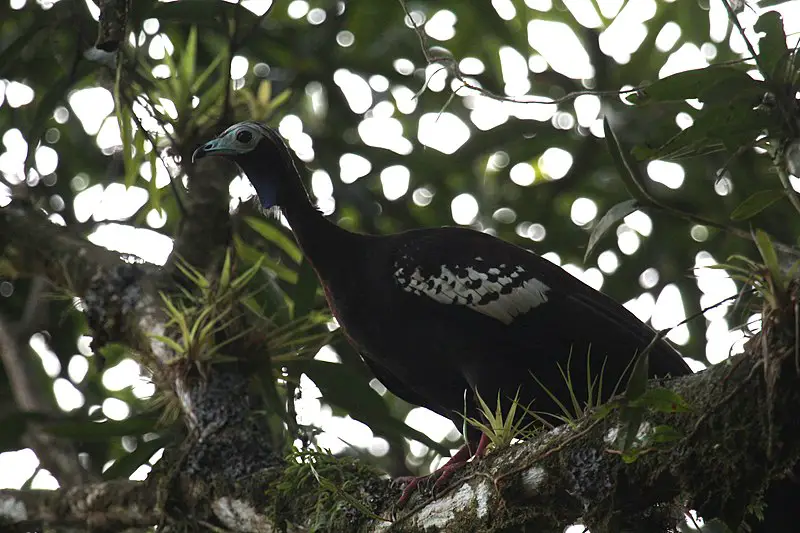
The Trinidad piping guan is an amazing bird endemic to the island of Trinidad. It is a part of the Cracidae family, and its closest living relative is the blue-throated piping guan from South America.
This large bird resembles a turkey in appearance, standing out among others due to its unique features.
Its diet consists mainly of fruit that it finds while foraging through trees and shrubs in forests or woodlands habitats where it lives in pairs or small groups.
The Trinidad piping guan has become vulnerable over time because of habitat destruction caused by deforestation activities, making conservation efforts essential to ensure their survival as one more species added beautiful list of animals native to this Caribbean Island paradise.
Scientific classification:
| Kingdom | Animalia |
| Phylum | Chordata |
| Class | Aves |
| Order | Galliformes |
| Family | Cracidae |
| Genus | Pipile |
| Species | P. pipile |
37. White-Tailed Sabrewing
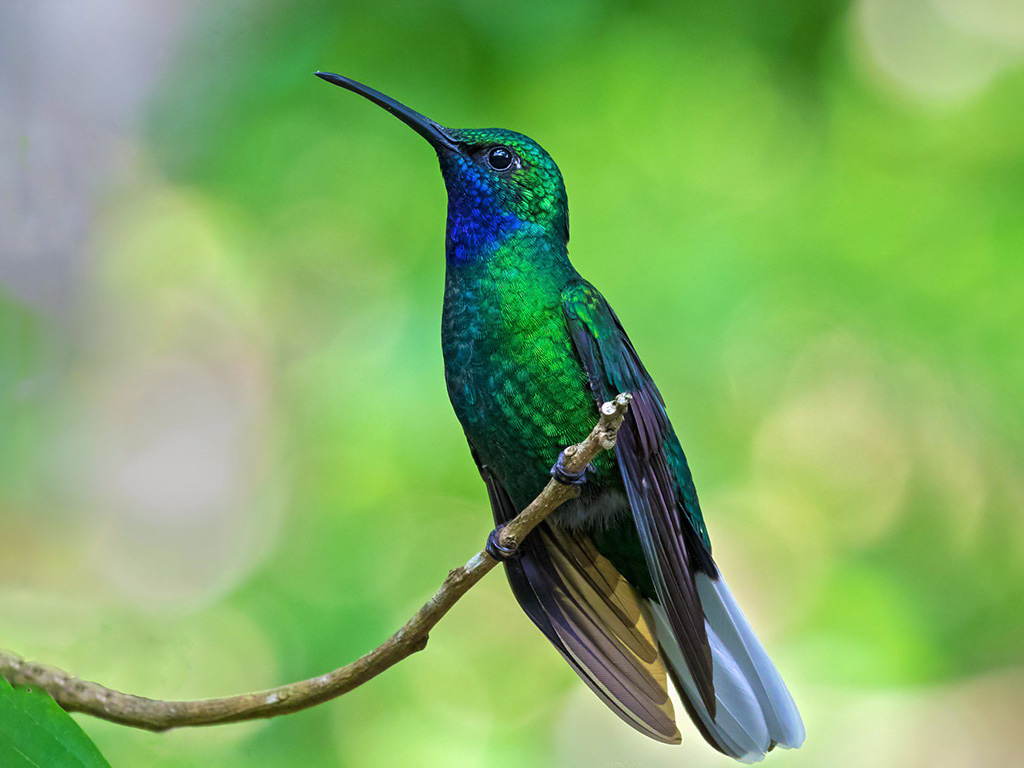
The White-tailed Sabrewing is a Near Threatened species of hummingbird that belongs to the Trochilini tribe of subfamily Trochilinae. It can be found in Tobago and Venezuela, where it lives in forests and scrublands.
This bird has an average size of 12–13 cm long with males weighing 9.5–10.5 g while females are assumed to be lighter than males but this hasn’t been confirmed yet.
Its plumage is mainly brownish-green on its back while its underparts have either grey or rufous colouration depending on their sex; both genders have white tips at the end of their tails which give them their name – White-tailed sabrewing.
These birds feed mainly by hovering around flowers for nectar, as well as catching small insects like flies midair.
They also perform beautiful courtship displays such as dive bombing each other during mating season, making them amazing creatures to observe.
Scientific classification:
| Kingdom | Animalia |
| Phylum | Chordata |
| Class | Aves |
| Order | Apodiformes |
| Family | Trochilidae |
| Genus | Campylopterus |
| Species | C. ensipennis |
38. Blue-Black Grassquit
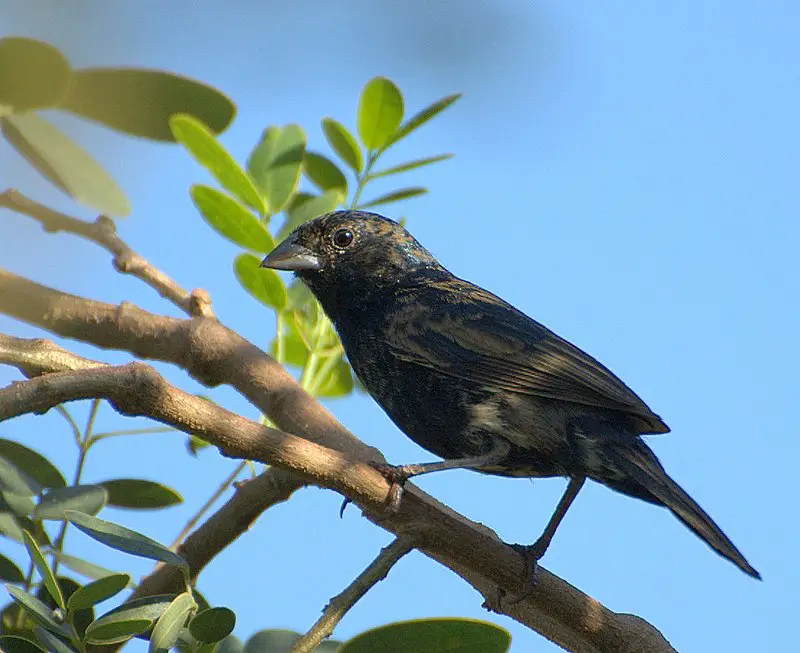
The Blue-black Grassquit is a small and vibrant bird belonging to the tanager family, Thraupidae.
It has an extremely wide range of distribution stretching from southern Mexico all the way through Central America and South America as far south as northern Chile, Argentina and Paraguay.
The male of this species features glossy blue-black feathers with yellowish primaries whereas females are less brightly coloured having predominantly greyish brown plumage.
They feed on insects such as ants, grasshoppers and beetles along with some grains they find in their habitats which include open woodlands near water sources or marshes.
These birds build nests made out of leaves lined with soft material like hair or wool at low level vegetation often close to water bodies where they can raise clutches up to two times during breeding seasons depending upon weather conditions around them.
Scientific classification:
| Kingdom | Animalia |
| Phylum | Chordata |
| Class | Aves |
| Order | Passeriformes |
| Family | Thraupidae |
| Genus | Volatinia Reichenbach, 1850 |
| Species | V. jacarina |
Also Featured In: Puerto Vallarta Birds You Should Know, Birds that You’ll Find in Chiapas
39. Golden-Olive Woodpecker
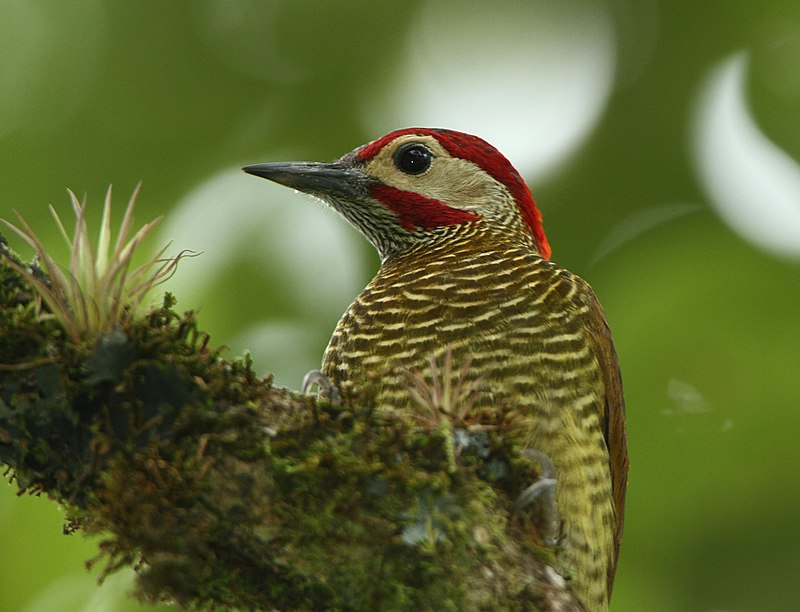
The Golden-olive Woodpecker is a colorful bird native to Mexico, Guyana, Argentina and Trinidad & Tobago. It can be recognized by its rust-colored wings and back as well as its bright yellow throat.
This species of woodpecker measures about 20 cm in length with an average weight between 25 – 36 grams. Its diet consists mainly of insects but it also feeds on fruits such as figs or berries when available.
The birds usually make their nests in tree cavities where they lay two to five eggs at once which are incubated for 11–14 days before hatching.
These woodpeckers have been observed living up to 8 years old in the wild making them quite long lived compared to many other species.
Scientific classification:
| Kingdom | Animalia |
| Phylum | Chordata |
| Class | Aves |
| Order | Piciformes |
| Family | Picidae |
| Genus | Colaptes |
| Species | C. rubiginosus |
40. Spectacled Thrush
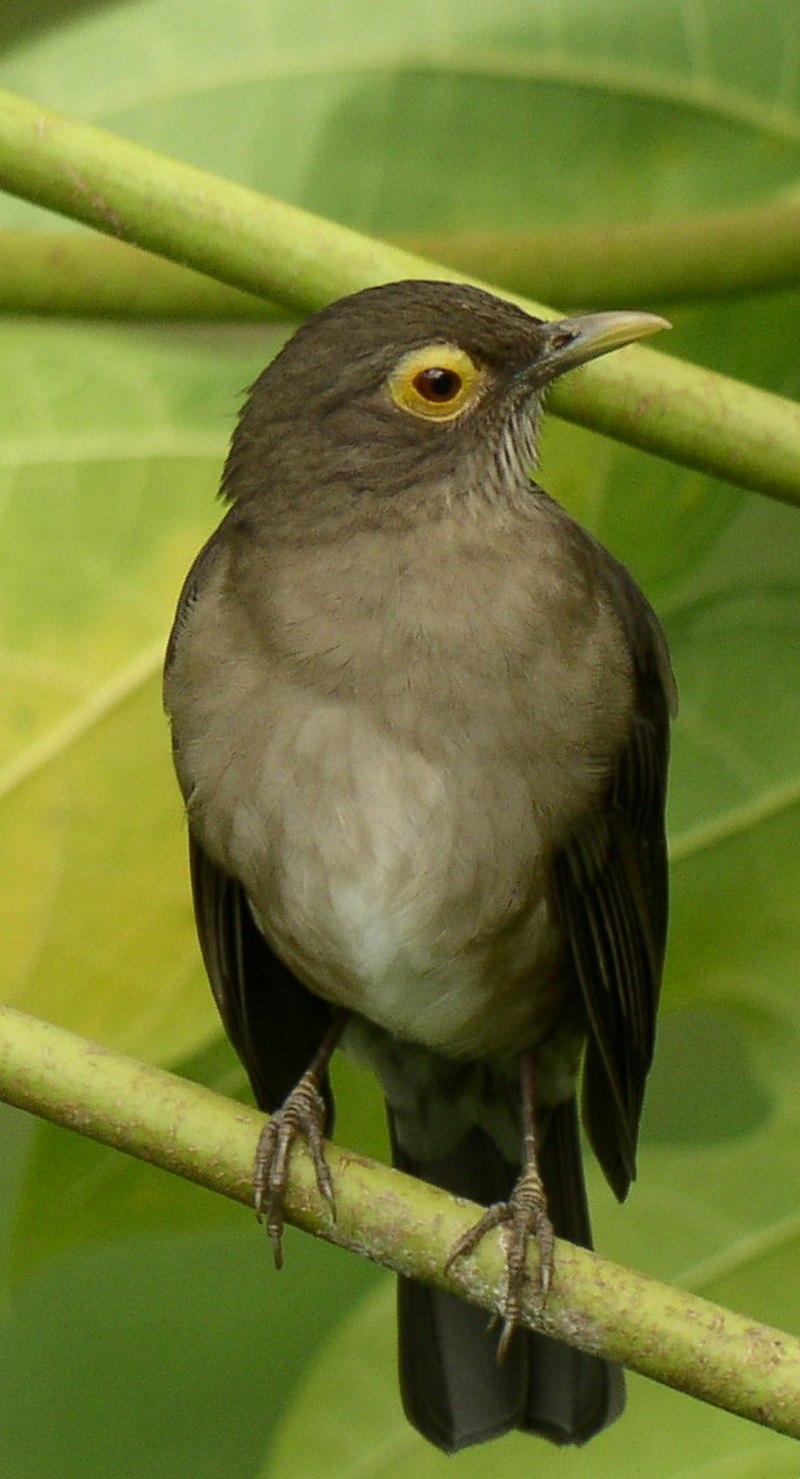
The Spectacled Thrush is a bird that can be found in the Lesser Antilles and South America from Colombia to Brazil. In Trinidad and Tobago, it’s known as Big-eye Grieve.
It was once thought to be related to another species called Ecuadorian thrush but they are now classified separately. The Spectacled Thrush has yellow eyes with white spectacles around them, hence its name.
Its plumage is mainly brownish grey on top while being paler underneath with streaks of black markings across both sides of its body.
This bird typically feeds on fruits and insects, making it an omnivore by nature.
They also love bathing in water pools or streams during hot days which makes for some great sightings if you’re lucky enough.
All in all, the Spectacled Thrush plays an important role in our environment so their conservation should definitely not be overlooked.
Scientific classification:
| Kingdom | Animalia |
| Phylum | Chordata |
| Class | Aves |
| Order | Passeriformes |
| Family | Turdidae |
| Genus | Turdus |
| Species | T. nudigenis |
Also Featured In: Martinique Island Birds You Should Know,
41. Zone-Tailed Hawk
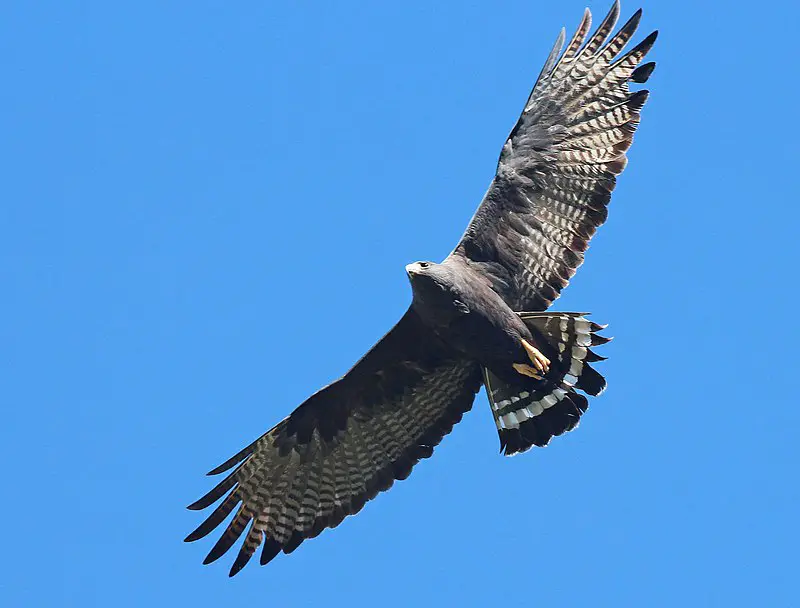
The Zone-tailed Hawk is a medium-sized bird found in warm and dry areas of the Americas. It has similar plumage to that of a turkey vulture, allowing it to blend into groups for camouflage.
Its diet consists mostly of small tetrapods such as mammals, reptiles or amphibians.
First described by George Robert Gray in 1844, this species can be identified by its greyish brown upperparts and wings with black barring on the tail feathers which are white underneath.
During flight they soar gracefully thanks to their rounded wings while keeping an eye out for prey below them.
Scientific classification:
| Kingdom | Animalia |
| Phylum | Chordata |
| Class | Aves |
| Order | Accipitriformes |
| Family | Accipitridae |
| Genus | Buteo |
| Species | B. albonotatus |
Also Featured In: Birds that Live in Morelos, Most Common Oaxaca Birds
42. Common Black Hawk
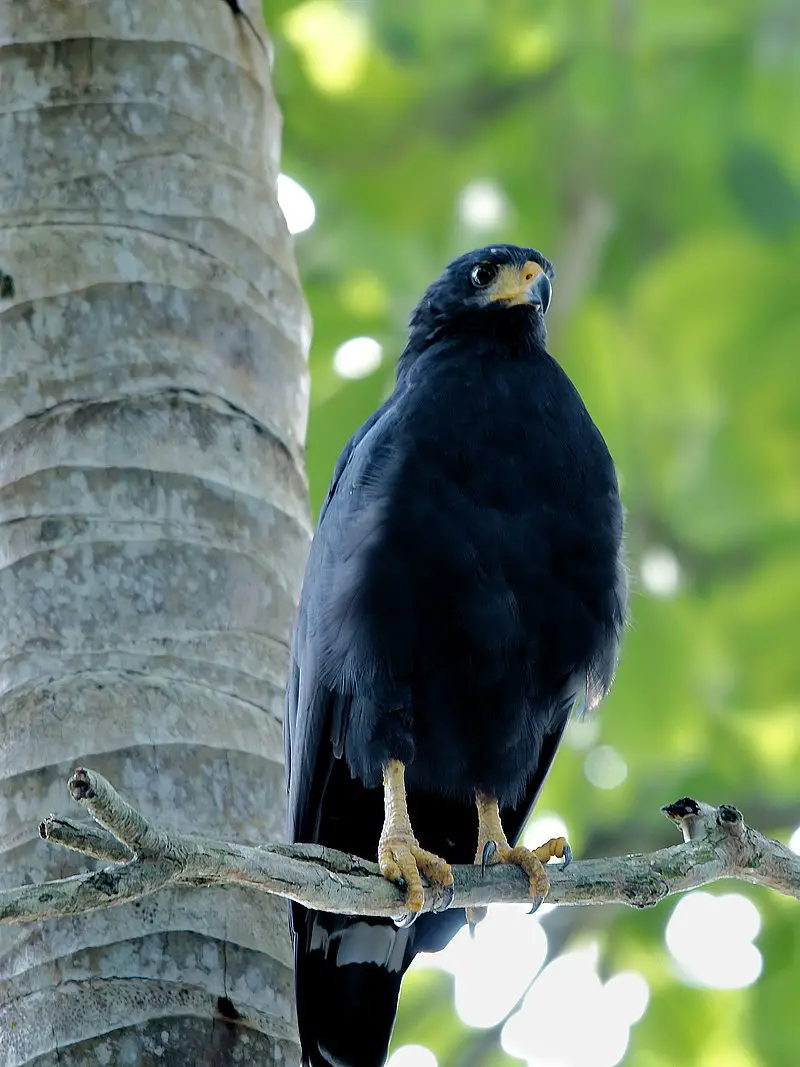
The Common black hawk is a magnificent bird of prey belonging to the Accipitridae family. It has very broad wings and is mainly dark gray or black in color, with a short tail featuring one broad white band and a white tip.
Averagely sized at 43-53 cm (17-21 in) long, they weigh around 930 g (33 oz). Its bill is also black and its eyes are yellow.
This species can be found throughout North America from Mexico to Canada; usually near rivers, lakes or coasts where there’s plenty of food available for them such as fish, small mammals & reptiles etc., They’re quite agile flyers who hunt their prey by swooping down quickly on it from above.
Scientific classification:
| Kingdom | Animalia |
| Phylum | Chordata |
| Class | Aves |
| Order | Accipitriformes |
| Family | Accipitridae |
| Genus | Buteogallus |
| Species | B. anthracinus |
43. White-Necked Jacobin
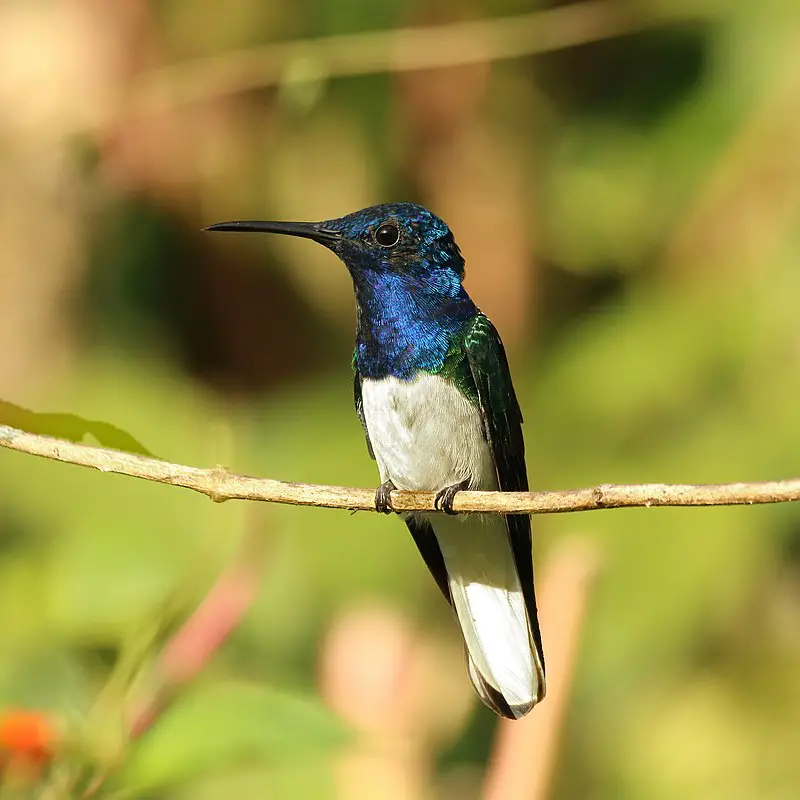
The White-necked Jacobin is a medium-sized hummingbird found throughout Central America, South America and Trinidad & Tobago. Its scientific name “Florisuga mellivora” translates to “honey loving flower hitter”.
It’s also known as the Great Jacobin or Collared Hummingbird due to its white neck collar which stands out against its glossy green upper parts and paler underside.
These birds are mainly nectar feeders but they have been known to eat some insects too.
They tend to inhabit open woodlands near water sources like streams, rivers and lakes where they can find their favorite food of nectar from flowers such as cacti, hibiscus shrubs and heliconias.
The males display an impressive courtship dance with wings whirring around in circles at high speed while singing loudly.
This unique species has captivated many nature lovers all over the world making it one of the most beloved hummingbirds on earth.
Scientific classification:
| Kingdom | Animalia |
| Phylum | Chordata |
| Class | Aves |
| Order | Apodiformes |
| Family | Trochilidae |
| Genus | Florisuga |
| Species | F. mellivora |
44. Anhinga

The Band-tailed Pigeon is a large, plump bird with an unmistakable long banded tail. It has mostly grayish plumage and can be found in western North America from Canada to Mexico.
This species primarily lives in forests of oak and conifers near water sources such as rivers or lakes where they feed on acorns, nuts and fruits from trees.
They are known for their cooing calls that echo through the woods.
These birds form huge flocks when migrating which often includes other pigeon species like the White-winged Dove or Mourning Dove.
During breeding season, they will nest high up in tall trees using twigs to build nests usually lined with grasses or feathers.
The female typically lays one white egg per clutch which she incubates alone while being fed by her mate during this time period.
Band-tailed Pigeons play an important role in our ecosystem by dispersing seeds throughout their range thus helping replenish native plants within those areas.
45. Green Heron
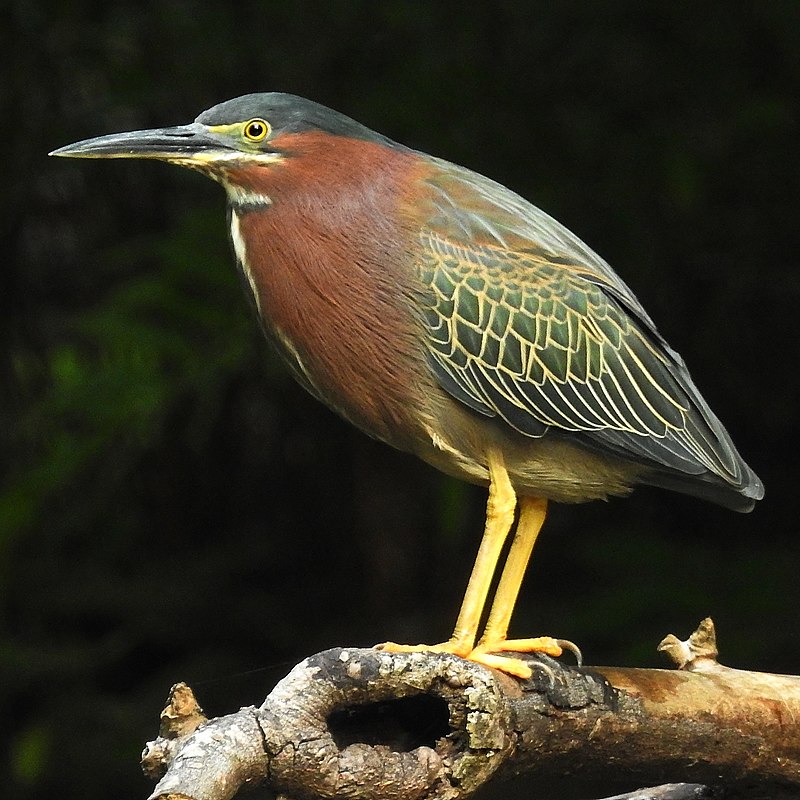
The Green Heron (Butorides virescens) is a small heron found throughout North and Central America.
It’s scientific name comes from Middle English ‘butor’ meaning bittern, combined with the Latin term for its distinctive greenish color – ‘virescens’.
For many years it was considered to be part of the same species as the Striated Heron (Butorides striata), commonly referred to as “green-backed herons”.
The nominate subspecies inhabits wetlands across much of this range, where they can be spotted stalking about in shallow water looking for fish or frogs on which to feed.
They are fascinating wading birds that have even been known to use tools such as sticks or baited lines when fishing.
Scientific classification:
| Kingdom | Animalia |
| Phylum | Chordata |
| Class | Aves |
| Order | Pelecaniformes |
| Family | Ardeidae |
| Genus | Butorides |
| Species | B. virescens |
46. Snowy Egret
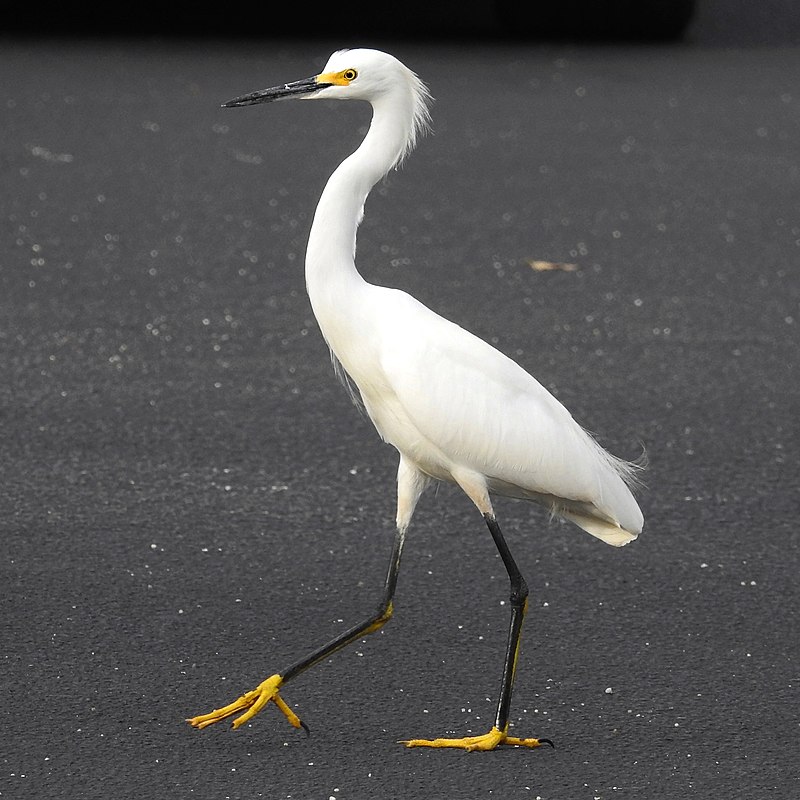
The Snowy Egret is a small white heron native to North America. Its scientific name, Egretta thula, comes from Provençal French for the little egret and an incorrect reference to the Black-necked Swan by Chilean naturalist Juan Ignacio Molina in 1782.
This beautiful bird has black legs with yellow feet, and a long plume of feathers on its head that often appears as if it’s wearing a crown.
It feeds primarily on insects and aquatic life like fish or frogs making it well adapted for both wetland habitats such as marshes or swamps plus coastal areas close to shorelines.
With their graceful movements they are truly delightful creatures to observe while out exploring nature.
Scientific classification:
| Kingdom | Animalia |
| Phylum | Chordata |
| Class | Aves |
| Order | Pelecaniformes |
| Family | Ardeidae |
| Genus | Egretta |
| Species | E. thula |
Also Featured In: Water Birds Live around Us, Birds that Live in the Deserts
47. Rufous Crab Hawk
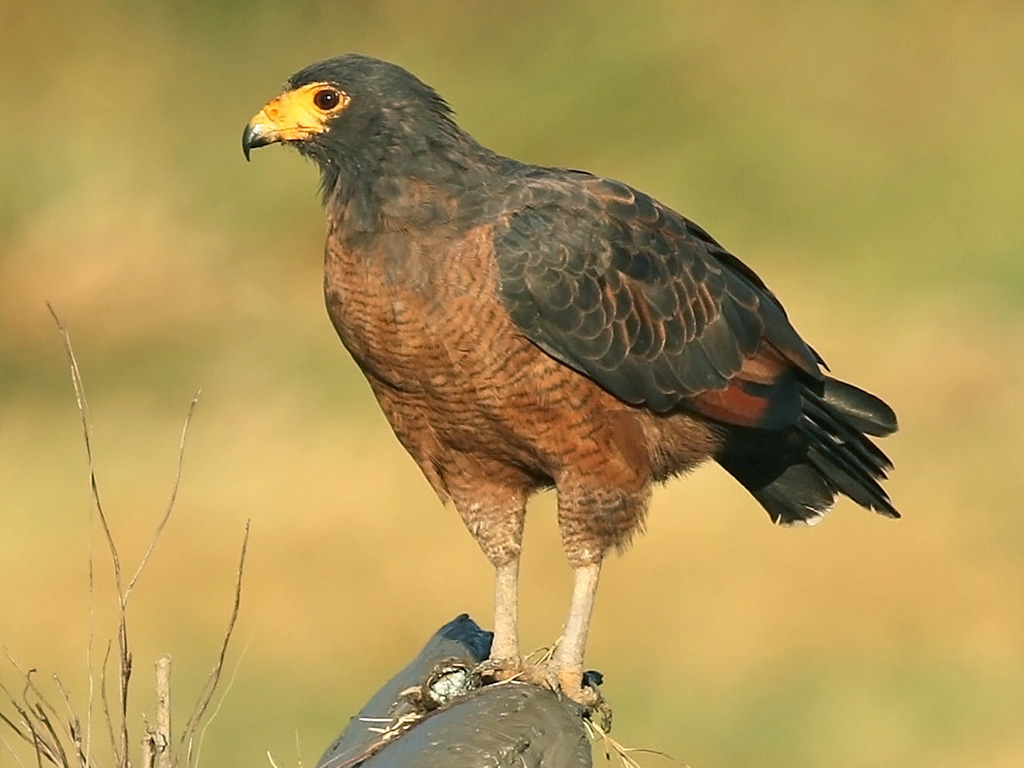
The Rufous crab hawk is a species of bird that falls under the subfamily Accipitrinae, which are commonly known as “true” hawks.
This Near Threatened species can be found in Trinidad and along South American coasts from eastern Venezuela to southern Brazil.
It was first described back in 1788 by German naturalist Johann Friedrich Gmelin who noted its many unique characteristics including its reddish-brown color, long tail feathers with white tips and yellow legs.
The Rufous crab hawk usually feeds on crabs but also eats small lizards or frogs when available.
They typically inhabit coastal areas such as mangroves, mudflats and beaches where they tend to roost near water sources during dusk or dawn hours while searching for food during the day time hours.
With their powerful talons these birds have no problem catching prey even amongst strong ocean currents.
Scientific classification:
| Kingdom | Animalia |
| Phylum | Chordata |
| Class | Aves |
| Order | Accipitriformes |
| Family | Accipitridae |
| Genus | Buteogallus |
| Species | B. aequinoctialis |
48. Maguari Stork
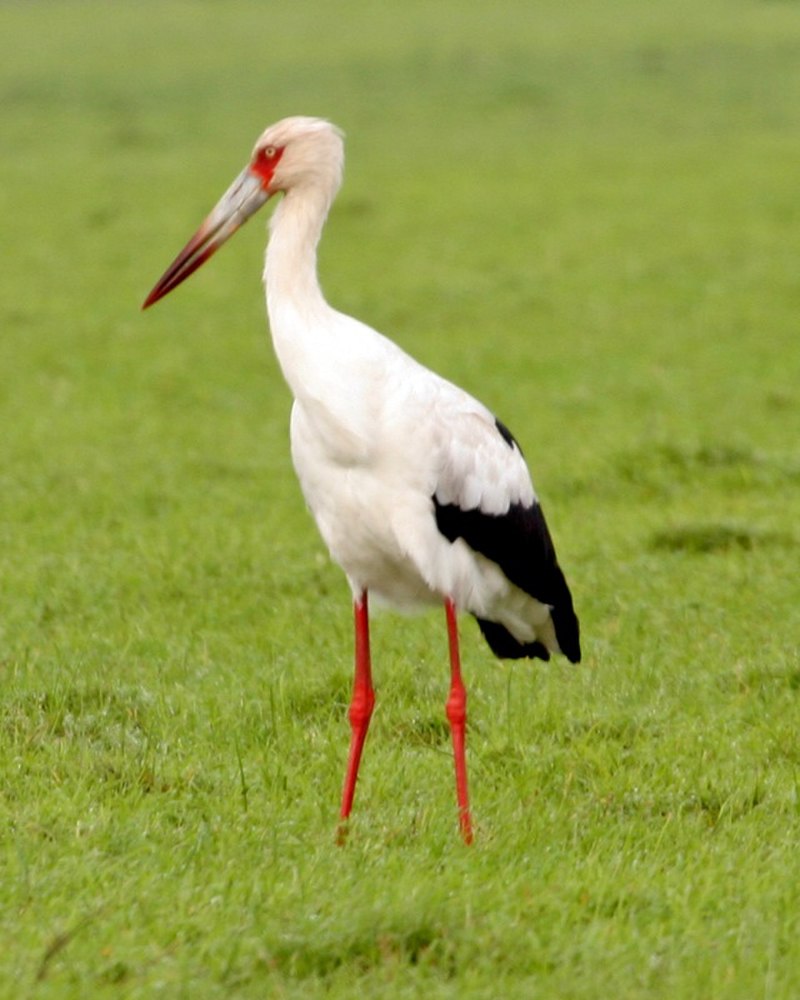
The Maguari stork is a large species of stork found in South America. It has similar features to the white stork, but it is slightly larger.
This bird can be identified by its black body with white patches on its wings and tail feathers and yellow legs which contrast against its dark feathers.
The maguari feeds mainly on fish, amphibians, reptiles, crustaceans and insects; they will also scavenge for food when necessary.
These birds breed during wetland seasons where their nests are made up of sticks or reeds built high above the ground in trees near water bodies such as rivers or swamps.
Their populations have been decreasing due to habitat loss from human activities such as agricultural expansion or deforestation however conservation efforts are being put into place to help protect this unique species so that we may continue enjoy watching these magnificent birds soar through our skies.
Scientific classification:
| Kingdom | Animalia |
| Phylum | Chordata |
| Class | Aves |
| Order | Ciconiiformes |
| Family | Ciconiidae |
| Genus | Ciconia |
| Species | C. maguari |
49. Spotted Rail
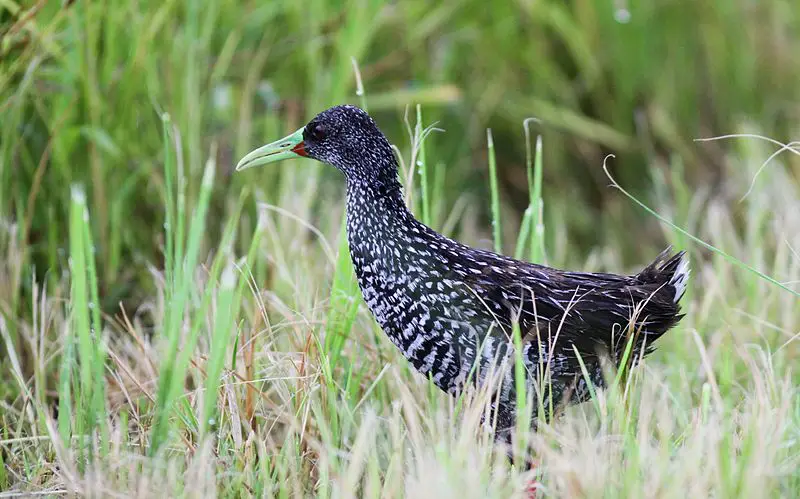
The Spotted Rail is a species of bird belonging to the subfamily Rallinae in the family Rallidae. It can be found across Mexico, Central America, Caribbean and South America.
This species was first described by French polymath Georges-Louis Leclerc Comte de Buffon in 1781 from a specimen collected in French Guiana.
These birds have an olive brown color with spotted blackish markings on their feathers which makes them easily recognizable amongst other species of railbirds.
They are usually seen near swamps or wet grasslands where they feed on small invertebrates like snails, worms and insects as well as seeds and aquatic plants depending upon seasonality and availability.
The IUCN has categorized this species under ‘Least Concern’ due to its wide range distribution but climate change may still pose threats for these birds if temperatures increase beyond certain limits .
Scientific classification:
| Kingdom | Animalia |
| Phylum | Chordata |
| Class | Aves |
| Order | Gruiformes |
| Family | Rallidae |
| Genus | Pardirallus |
| Species | P. maculatus |
Also Featured In: Most Common Birds Found in Nayarit,
50. Least Bittern
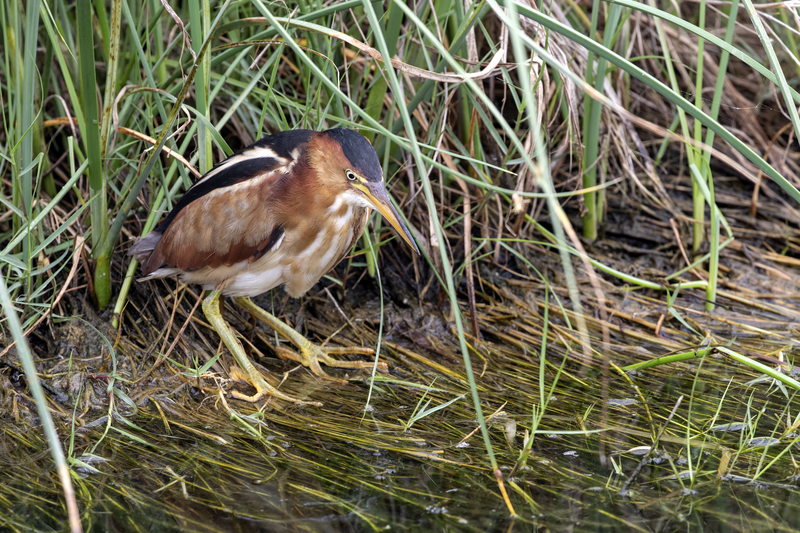
The Least Bittern is a small heron, the smallest of its family Ardeidae. It was first described by German naturalist Johann Friedrich Gmelin in 1789 and placed it with other herons, cranes, storks and bitterns into genus Ardea.
It can be found across much of North America to Central America as well as South American countries like Argentina, Uruguay and Brazil.
Its plumage varies from yellowish brown above to white below. The wings are short but pointed allowing for agile flight even over dense vegetation or water bodies where they migrate during breeding season.
They feed on fish, amphibians insects, crustaceans etc which makes them great hunters near shallow waters or marshes.
Least bitterns build their nests within reeds making them hard to spot while protecting them against predators at the same time providing safety for their eggs & young ones.
Scientific classification:
| Kingdom | Animalia |
| Phylum | Chordata |
| Class | Aves |
| Order | Pelecaniformes |
| Family | Ardeidae |
| Genus | Ixobrychus |
| Species | I. exilis |
Also Featured In: Wetlands Birds You Should Know, Small Birds Live in Vermont
51. Pauraque
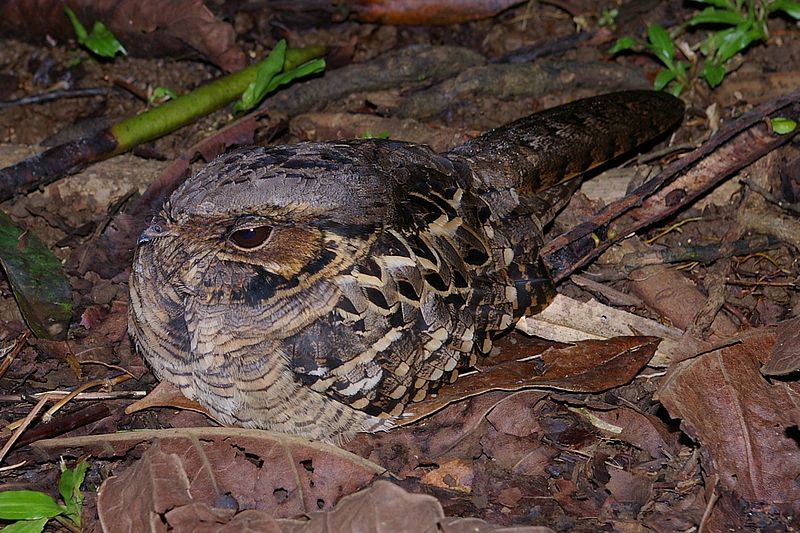
The Pauraque is a nightjar species belonging to the genus Nyctidromus and found in subtropical and tropical regions of the New World. It was formally described by German naturalist Johann in 1789.
Possessing unique features such as distinct white patches on its neck, it has adapted well to living near human settlements; making no noise during day time while roosting among tree branches or low shrubs in open areas with sparse vegetation like pastures, savannahs etc.,
The Pauraque feeds mainly on insects which helps reduce pest populations around agricultural fields.
This bird also plays an important role in maintaining healthy ecosystems across its range due to their habitat preferences for different stages of forest succession, from secondary growth forests to grasslands and scrublands.
Scientific classification:
| Kingdom | Animalia |
| Phylum | Chordata |
| Class | Aves |
| Order | Caprimulgiformes |
| Family | Caprimulgidae |
| Genus | Nyctidromus |
| Species | N. albicollis |